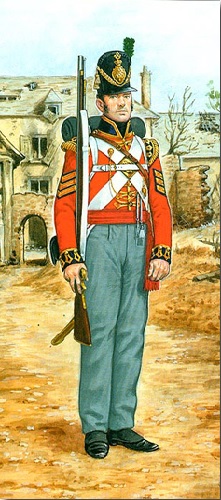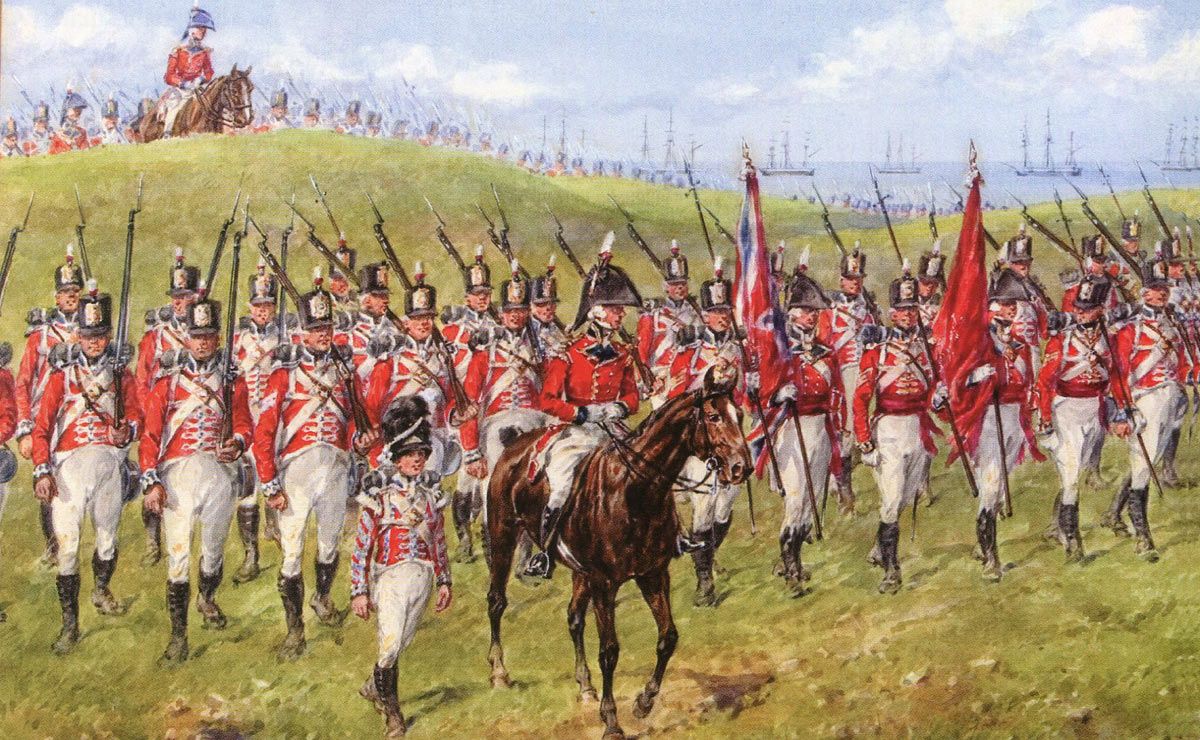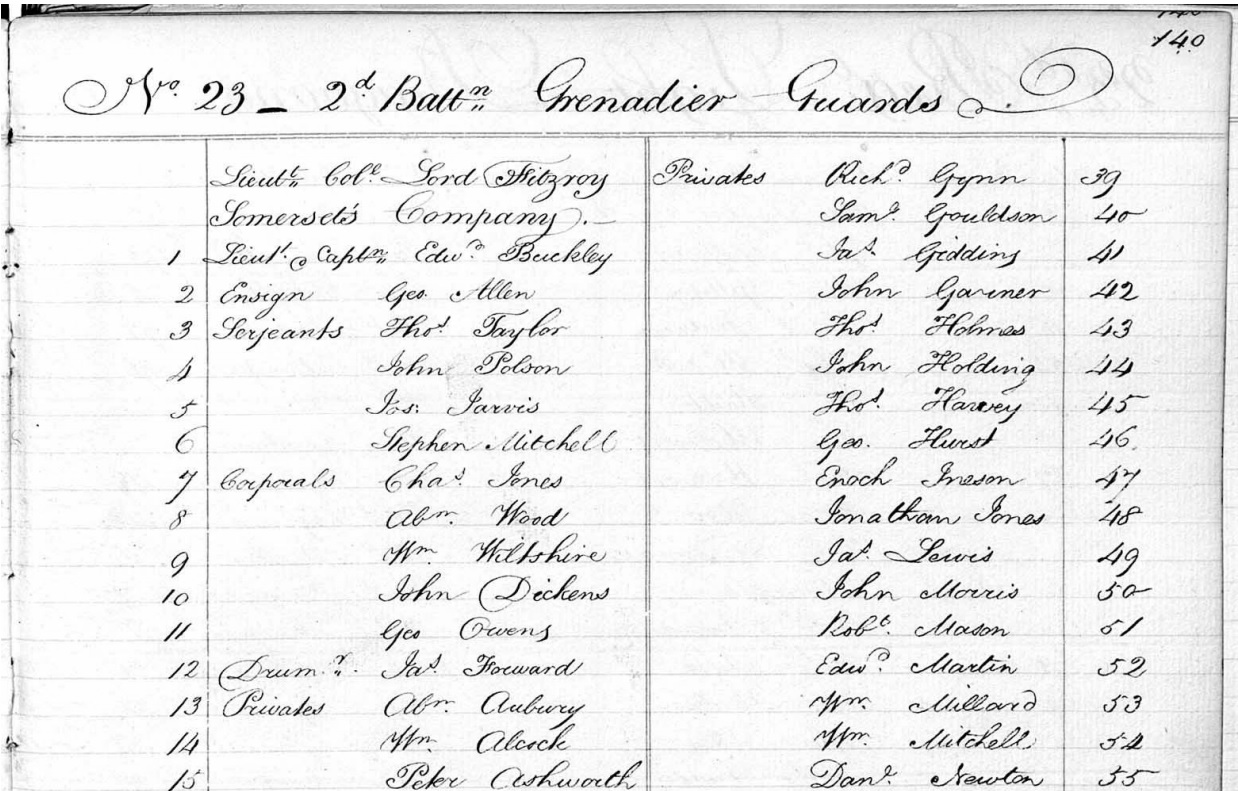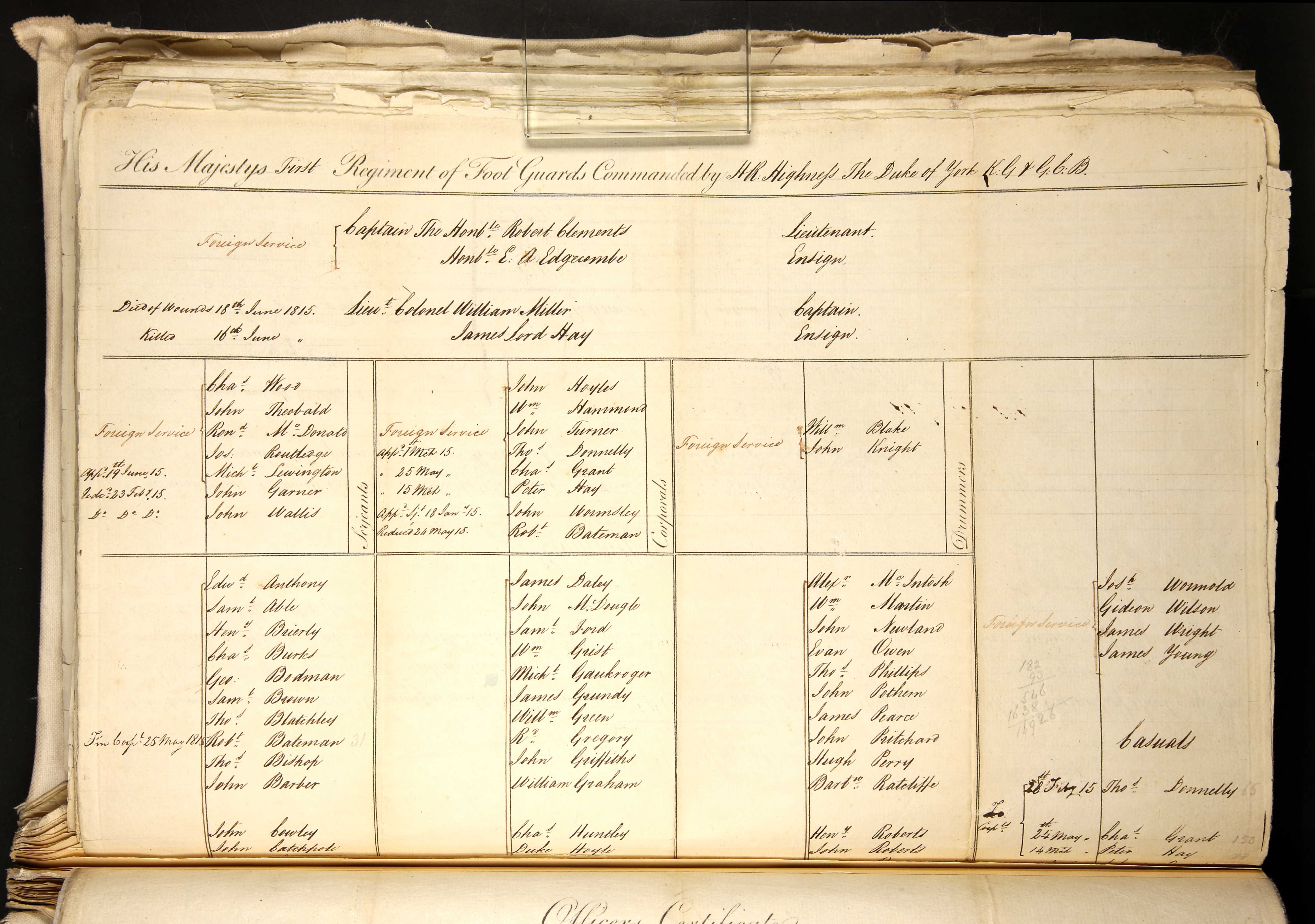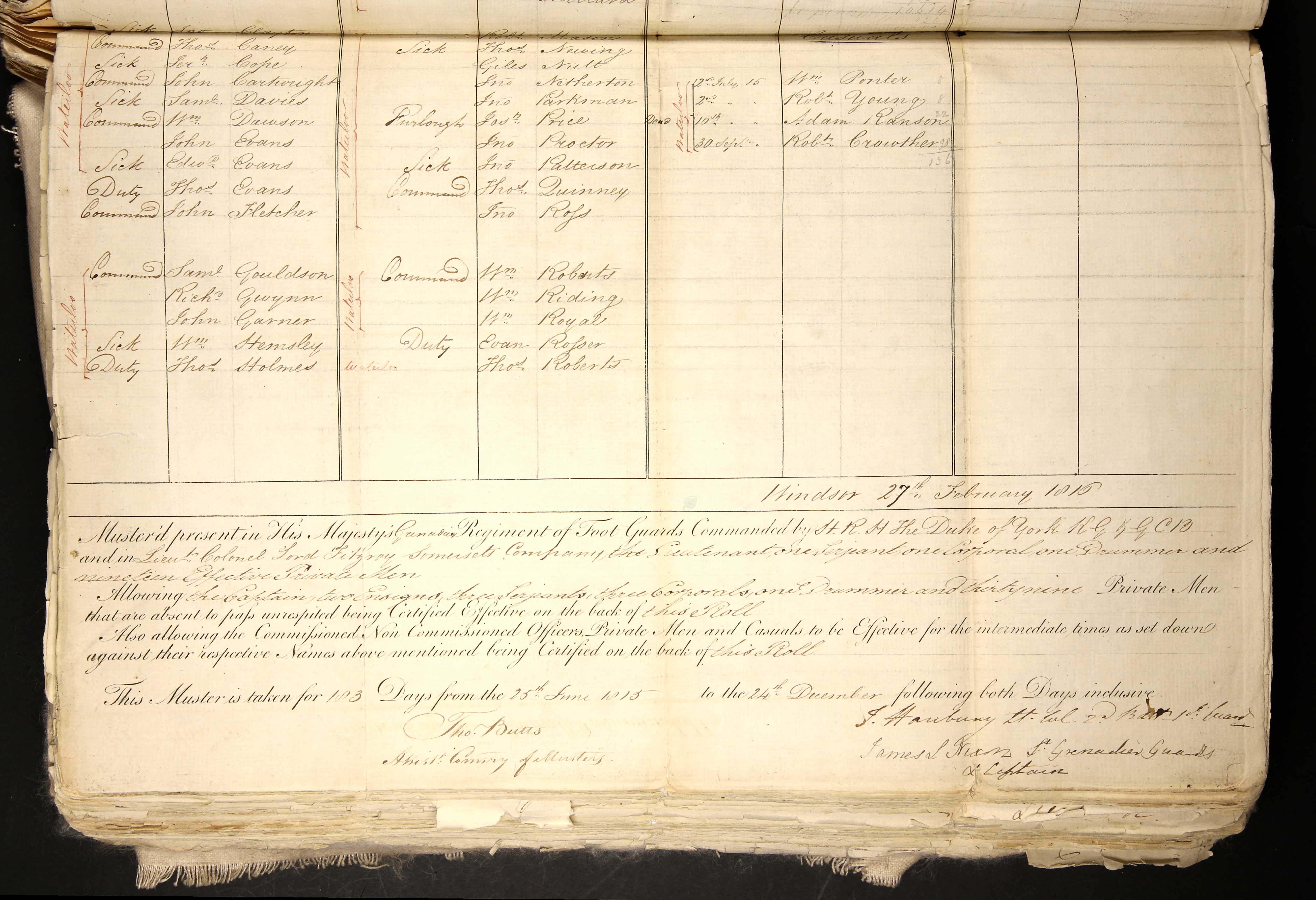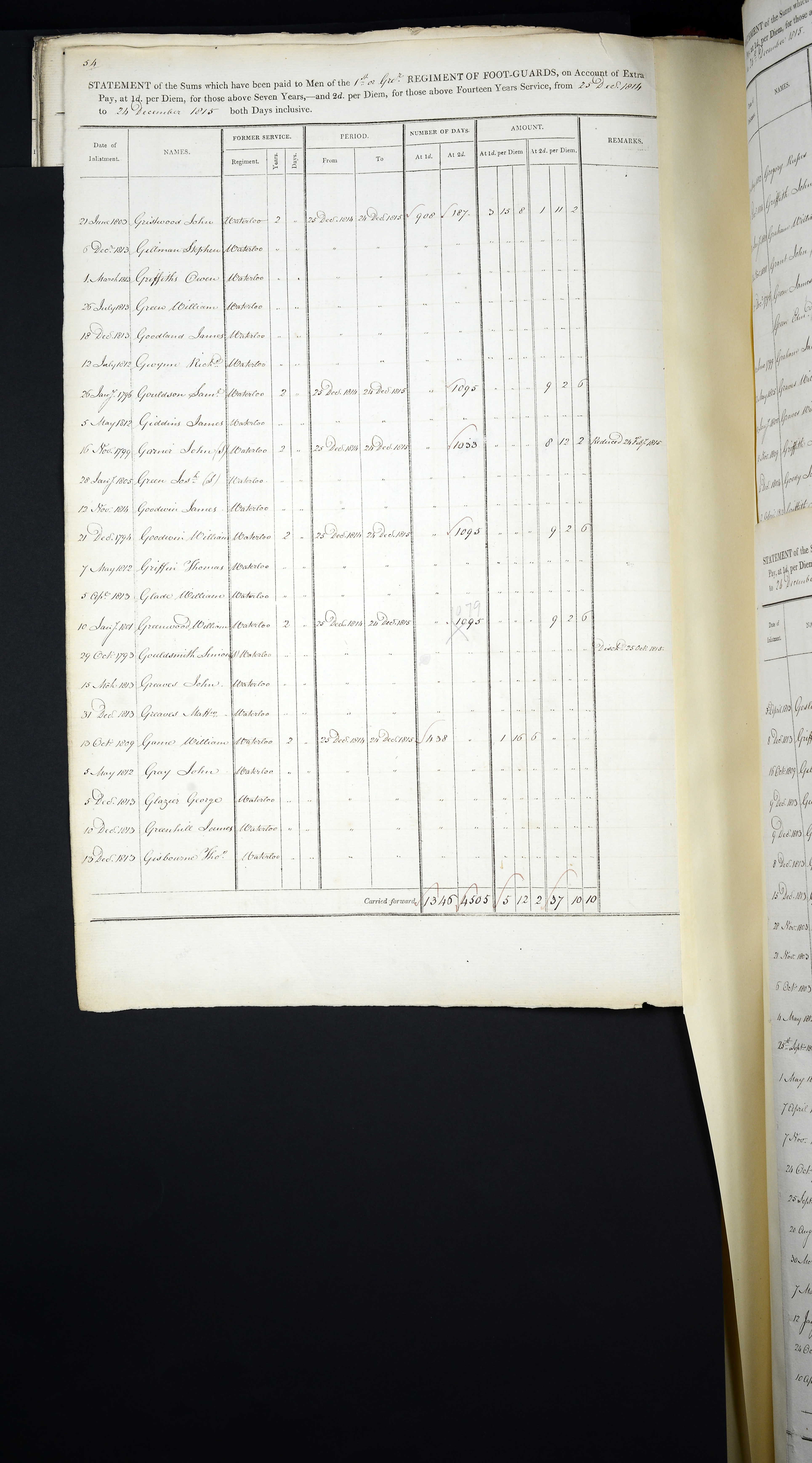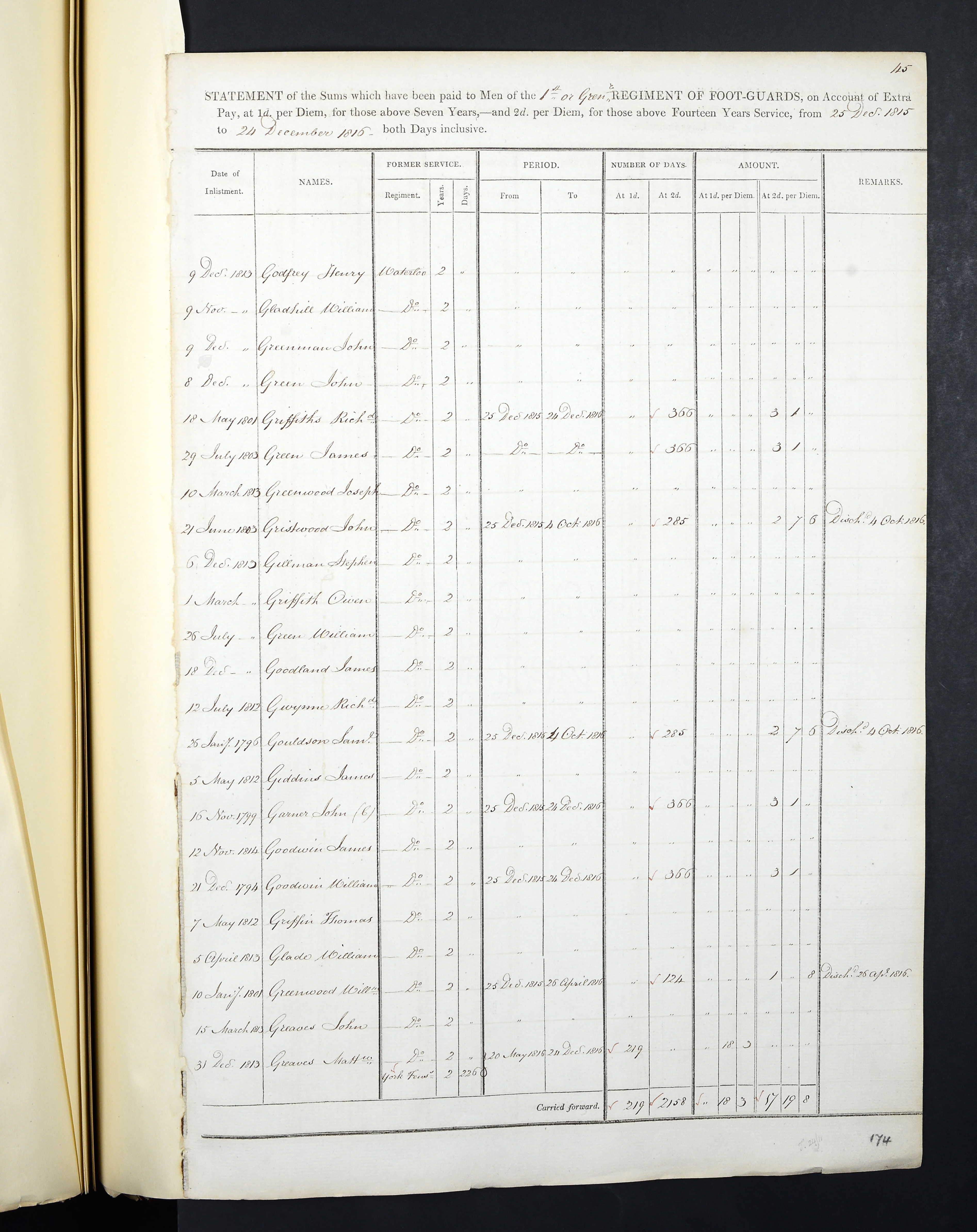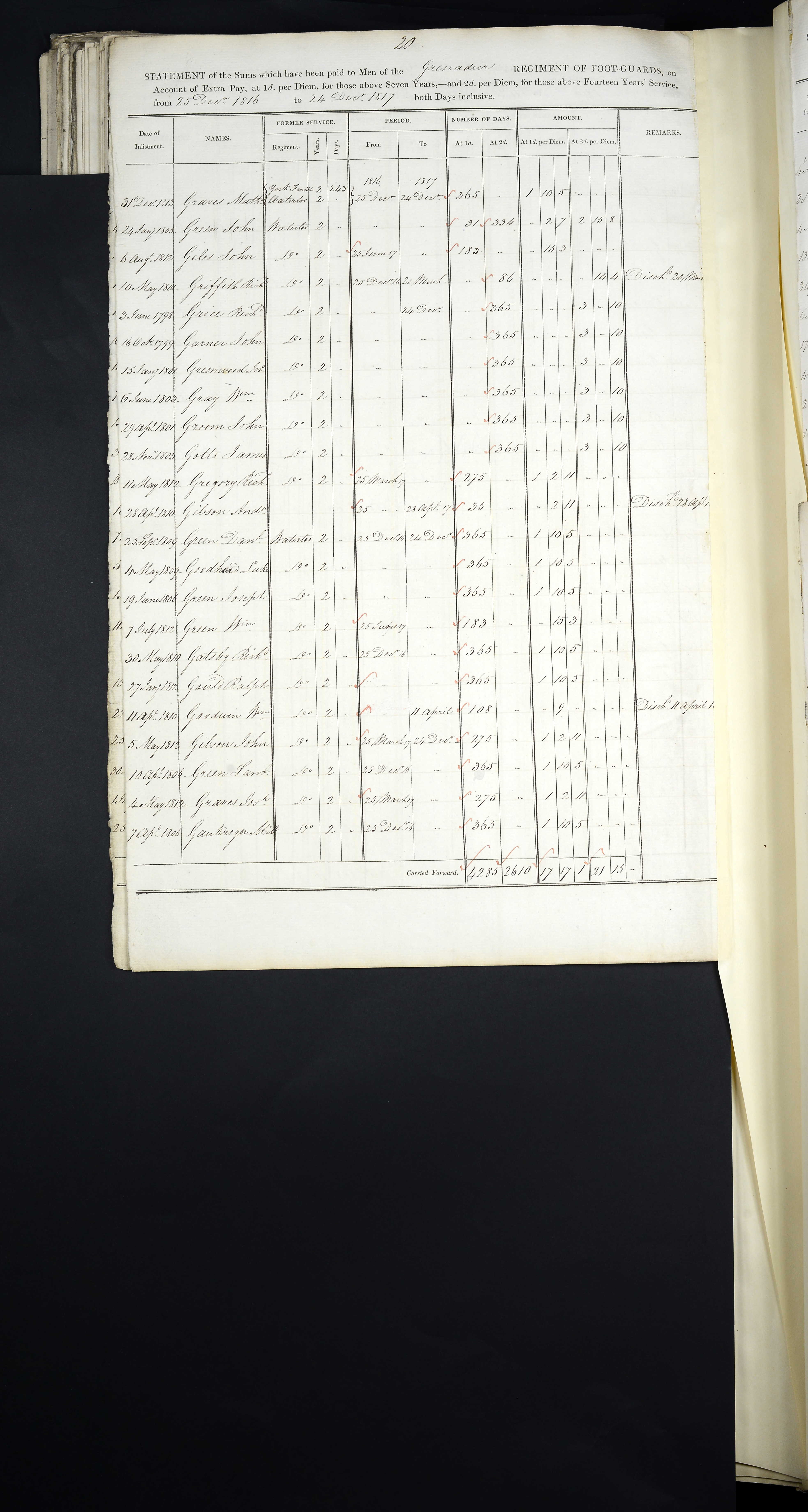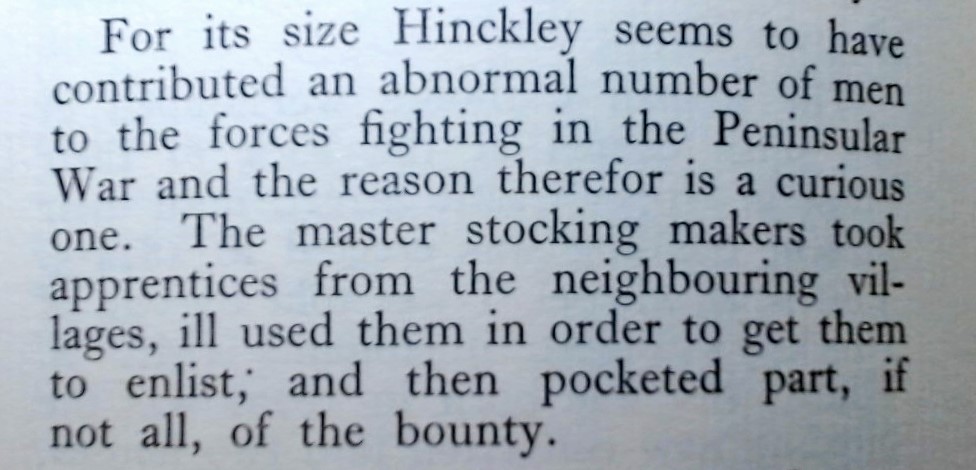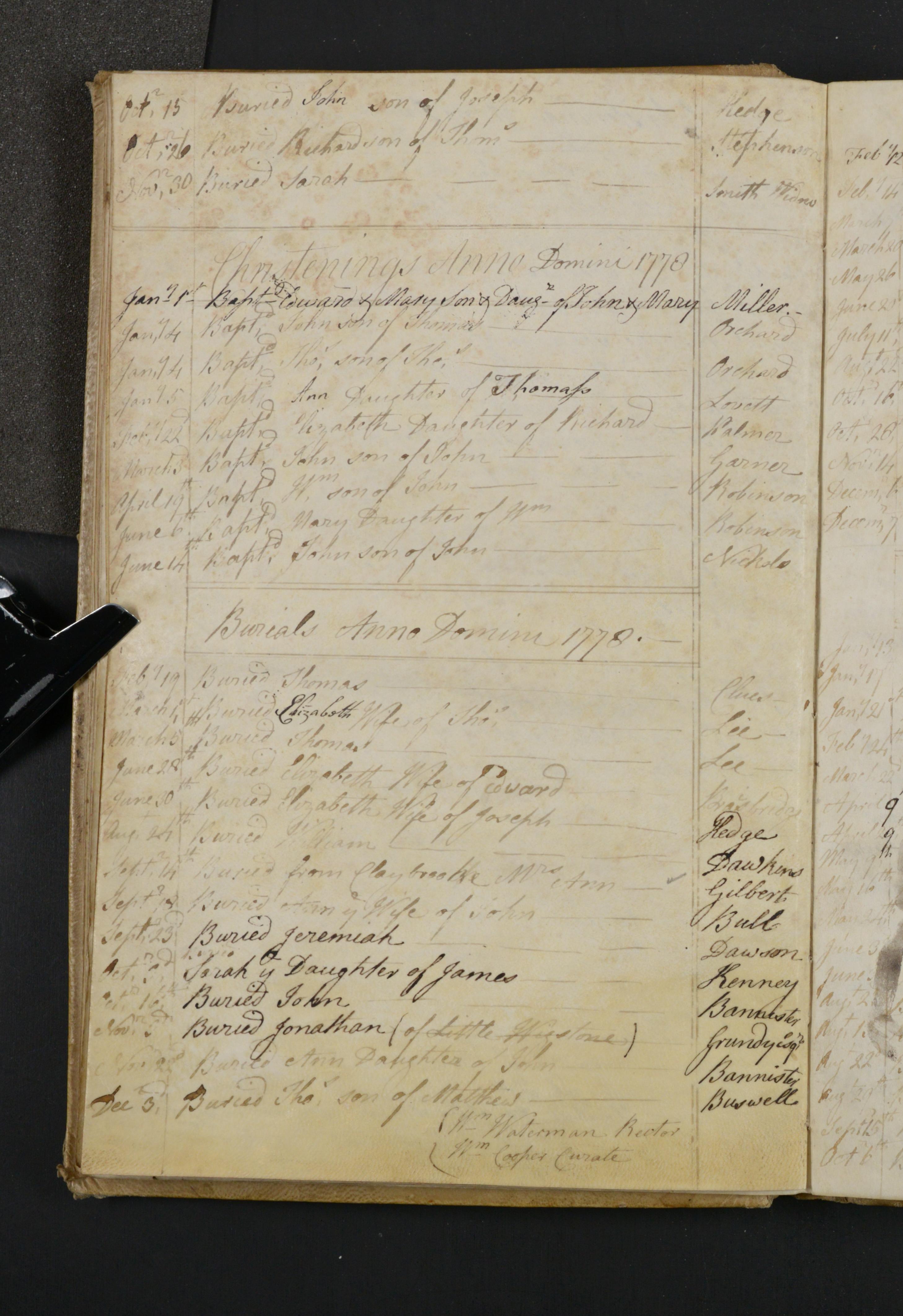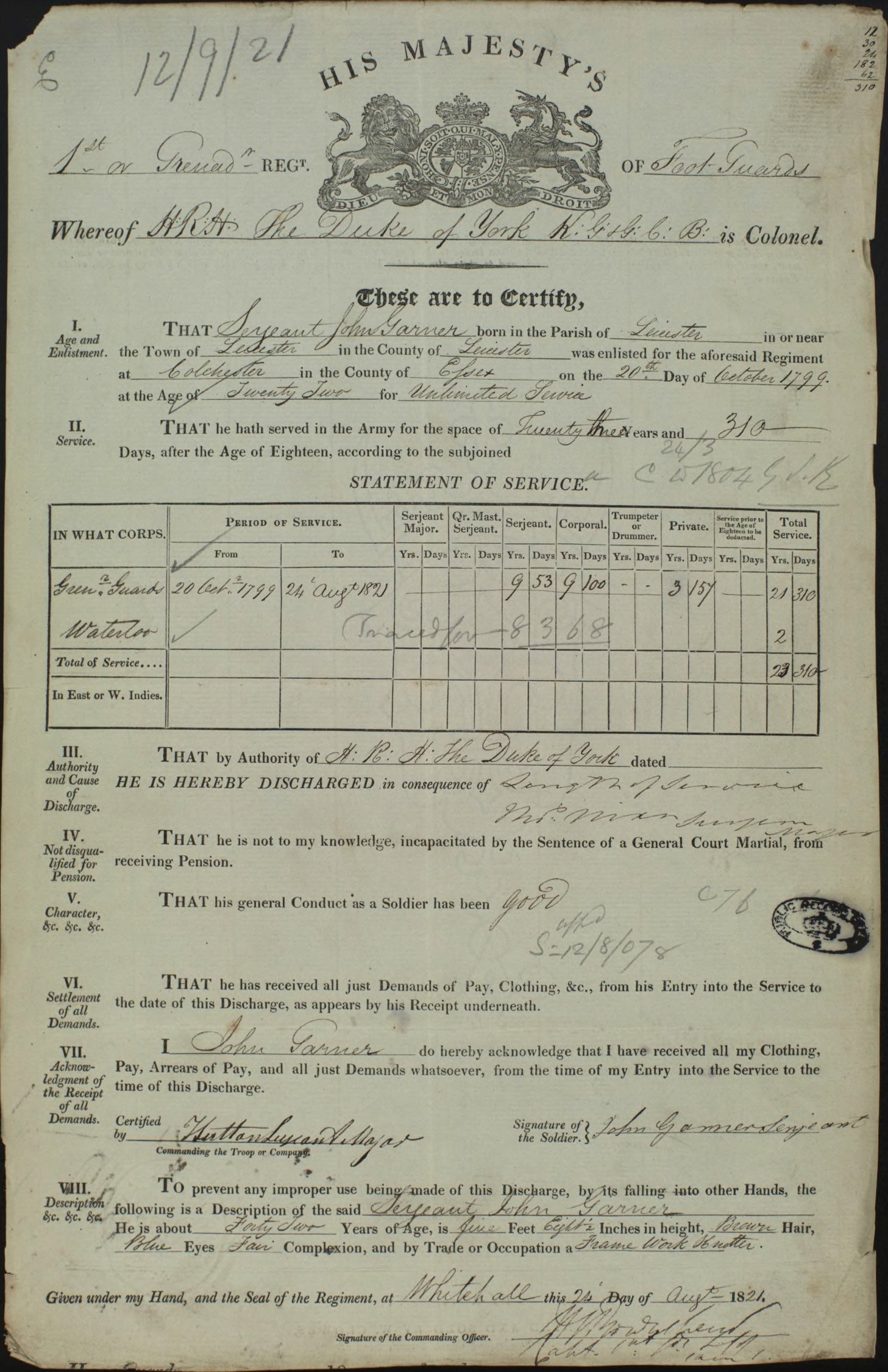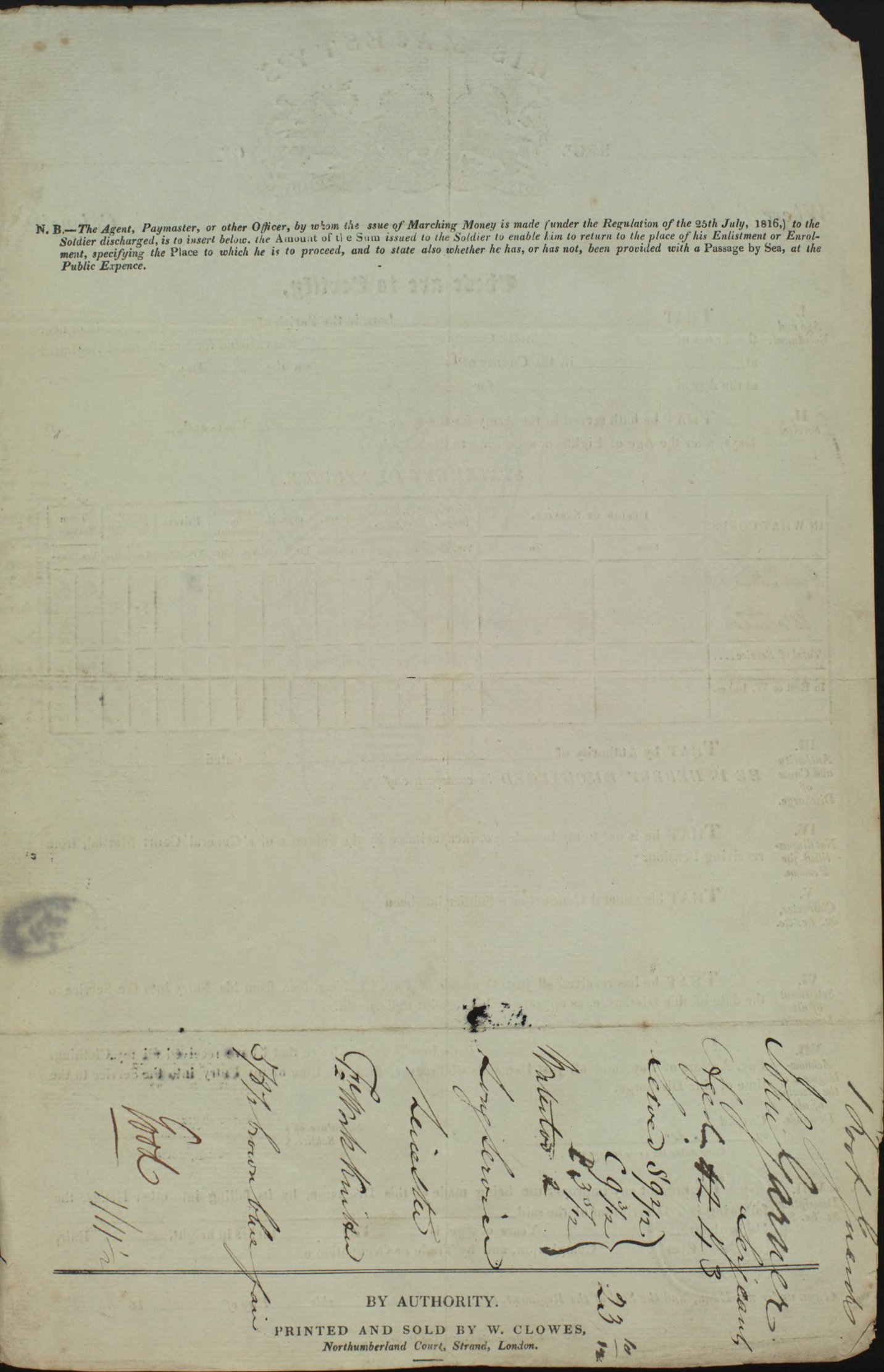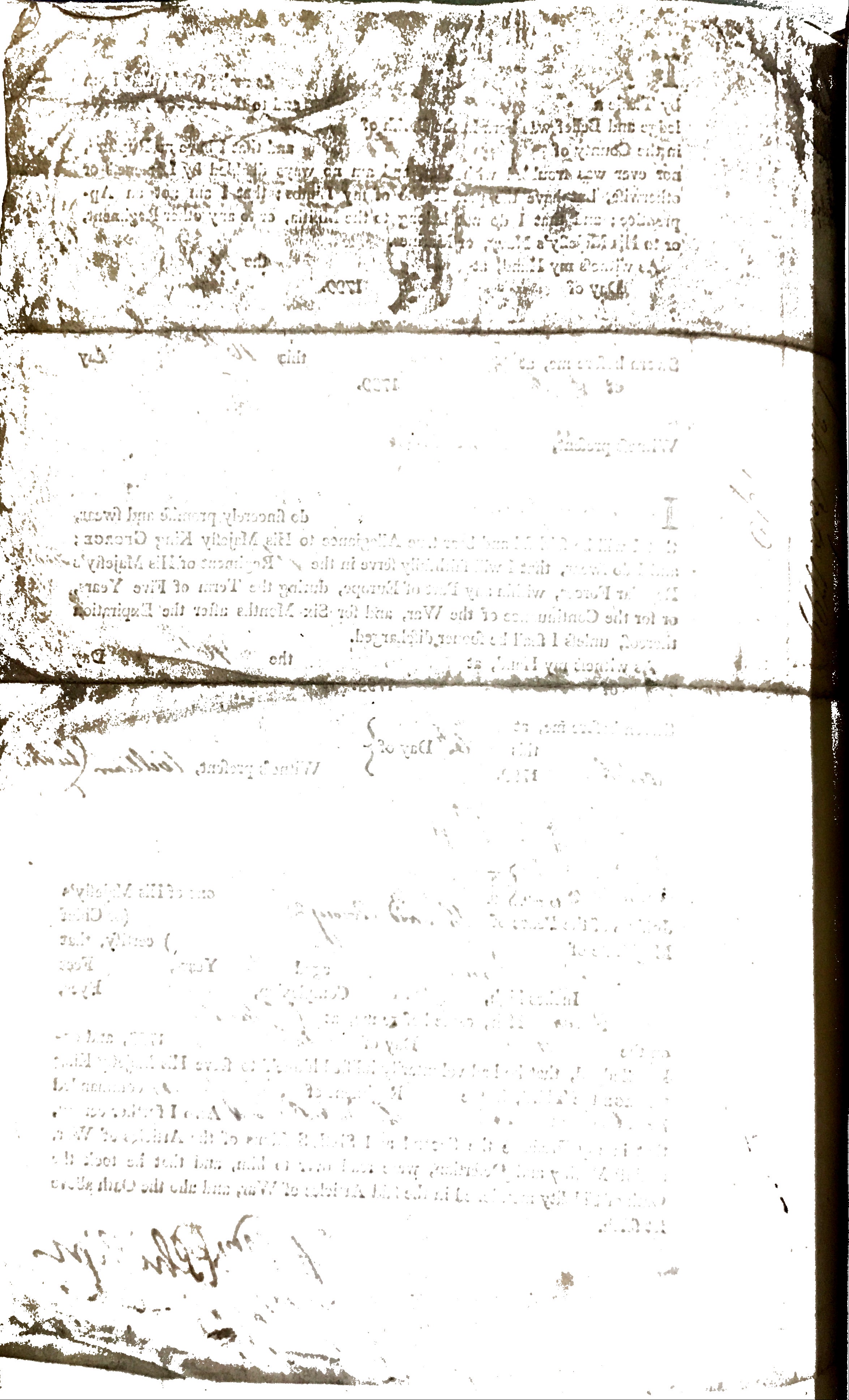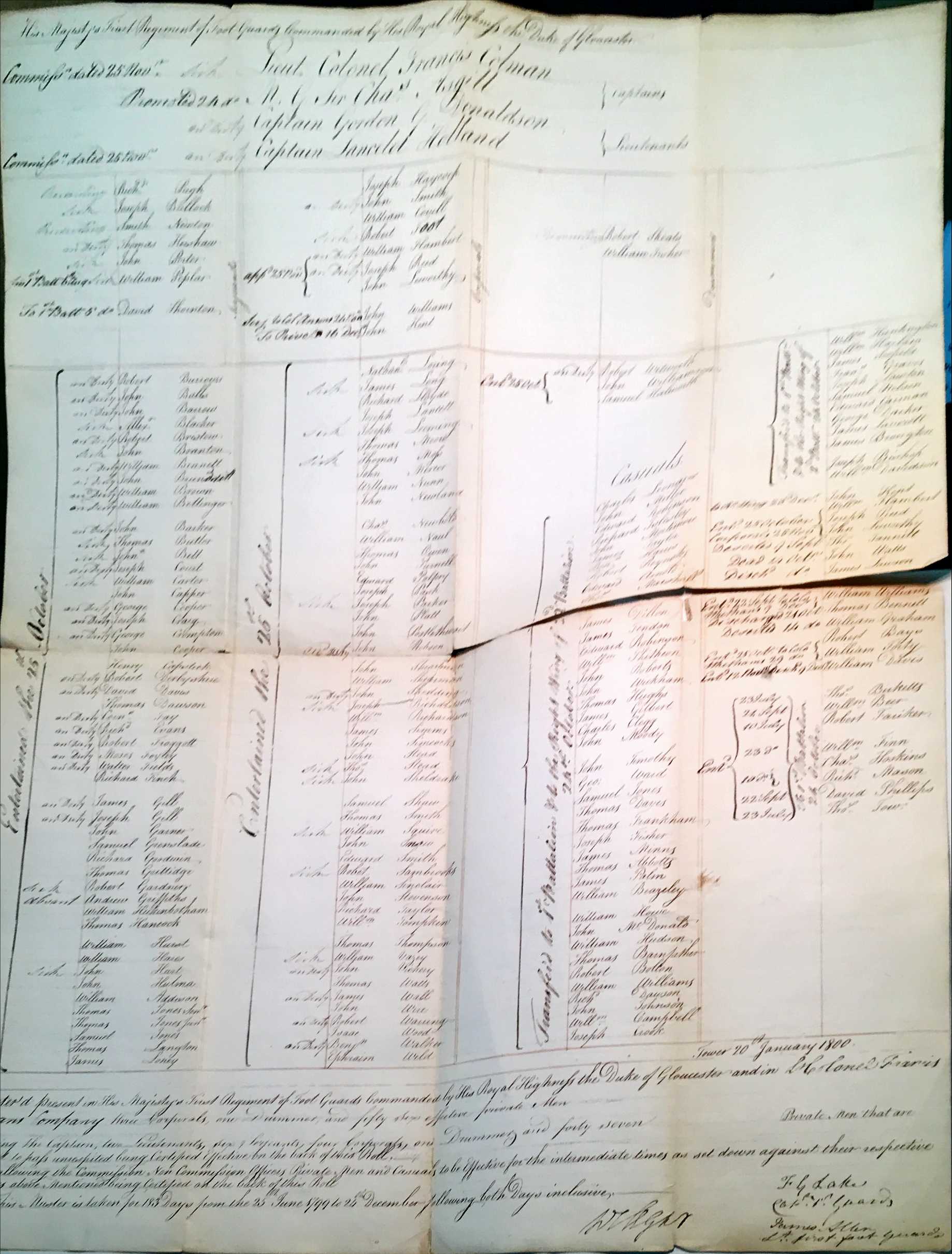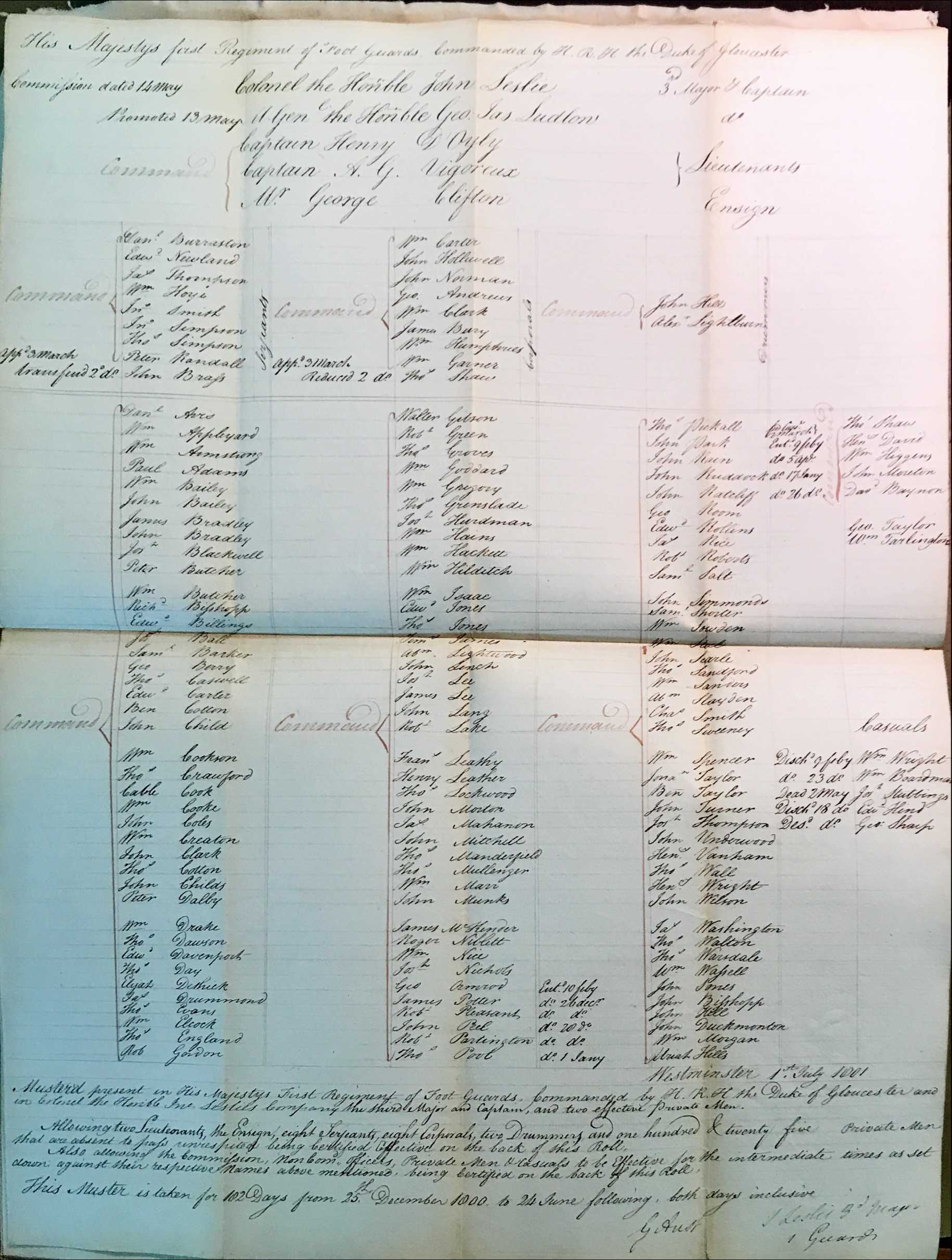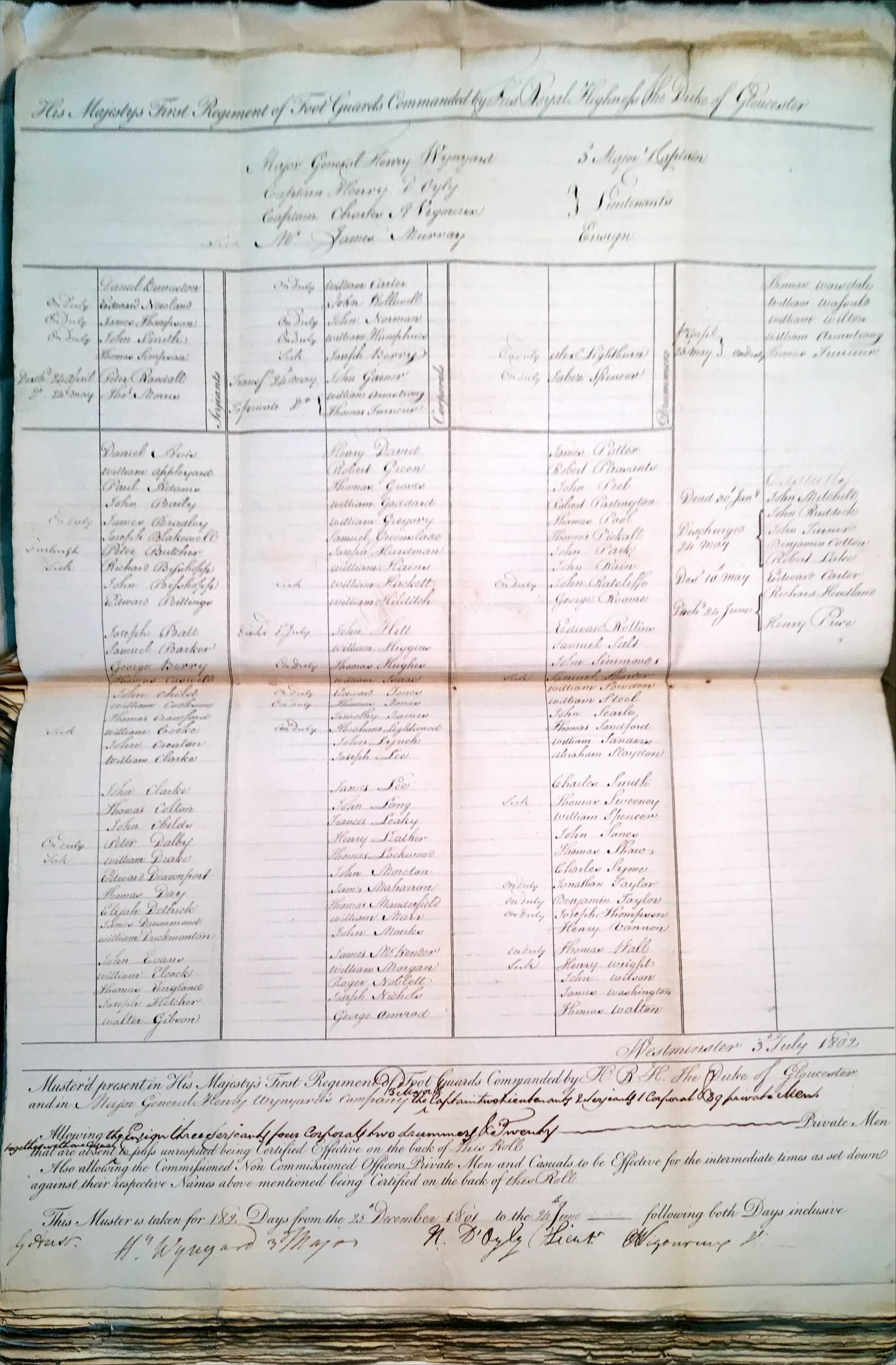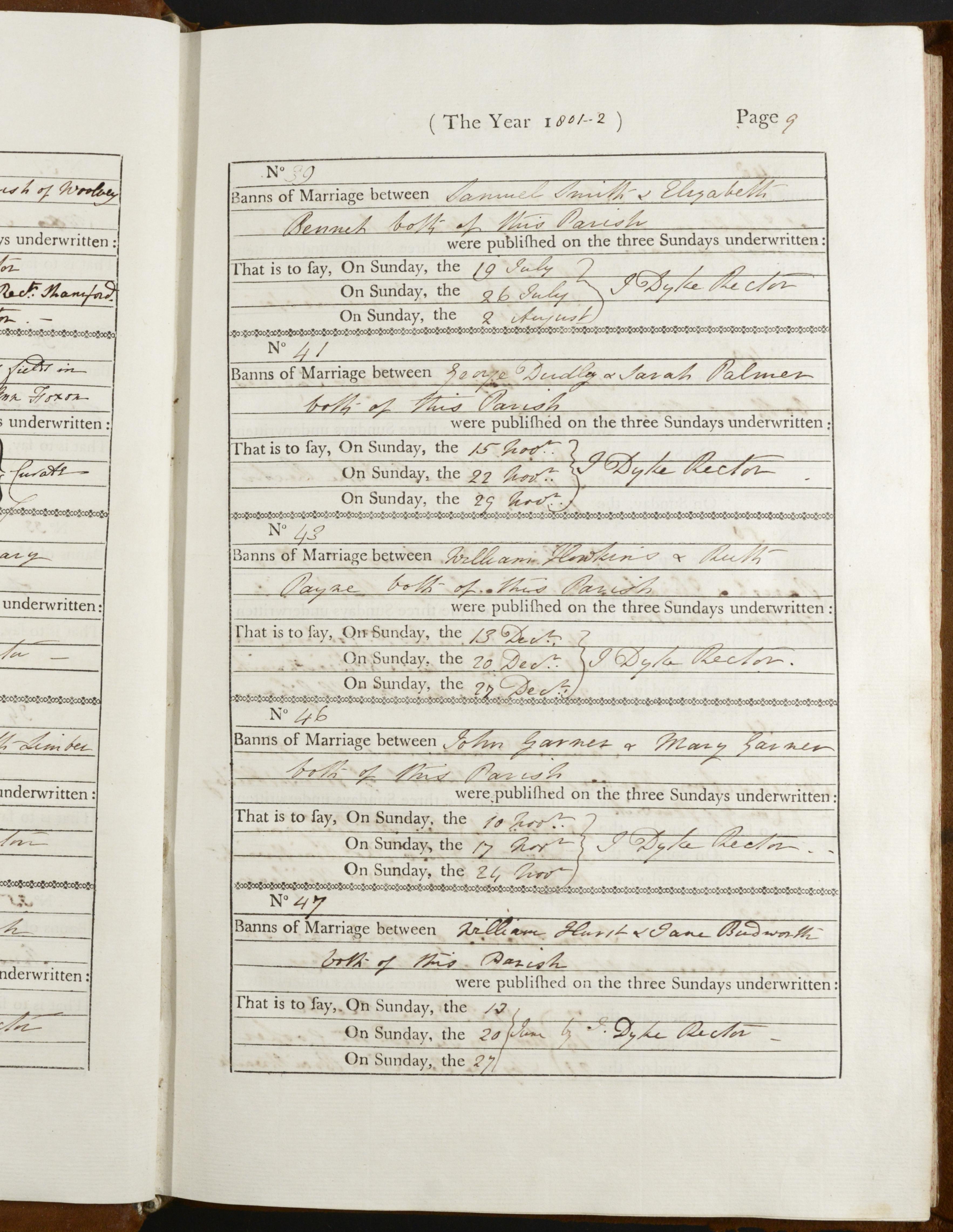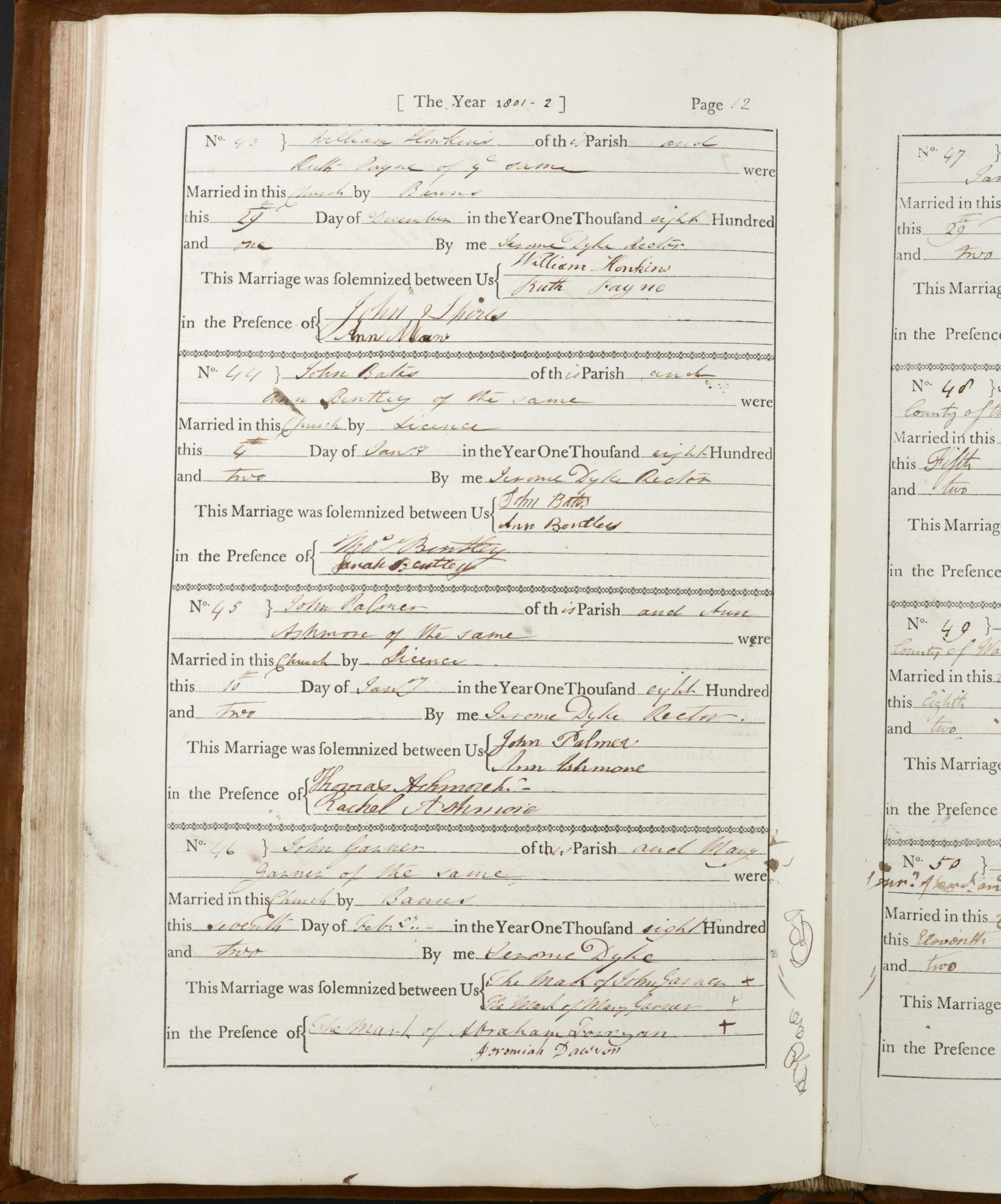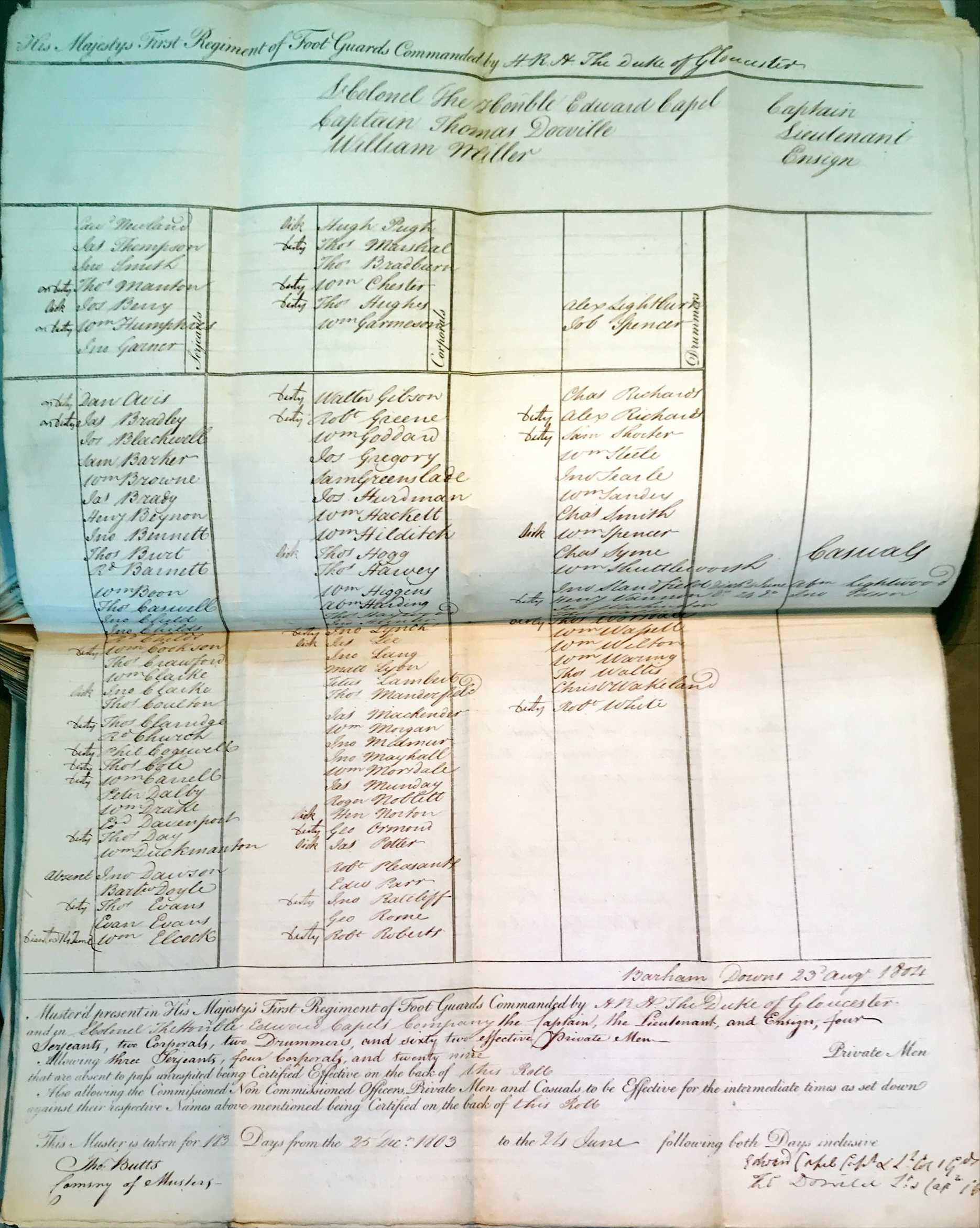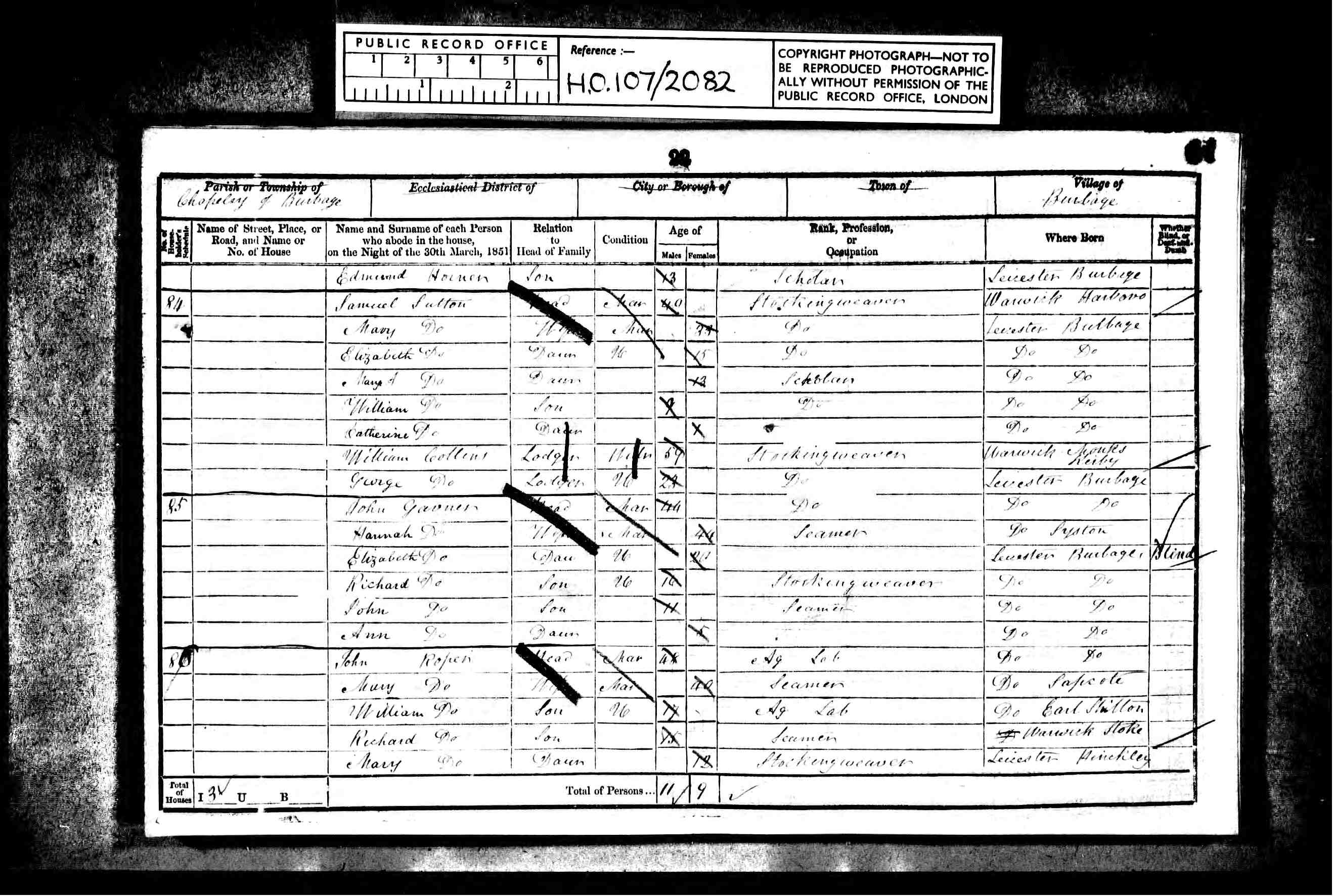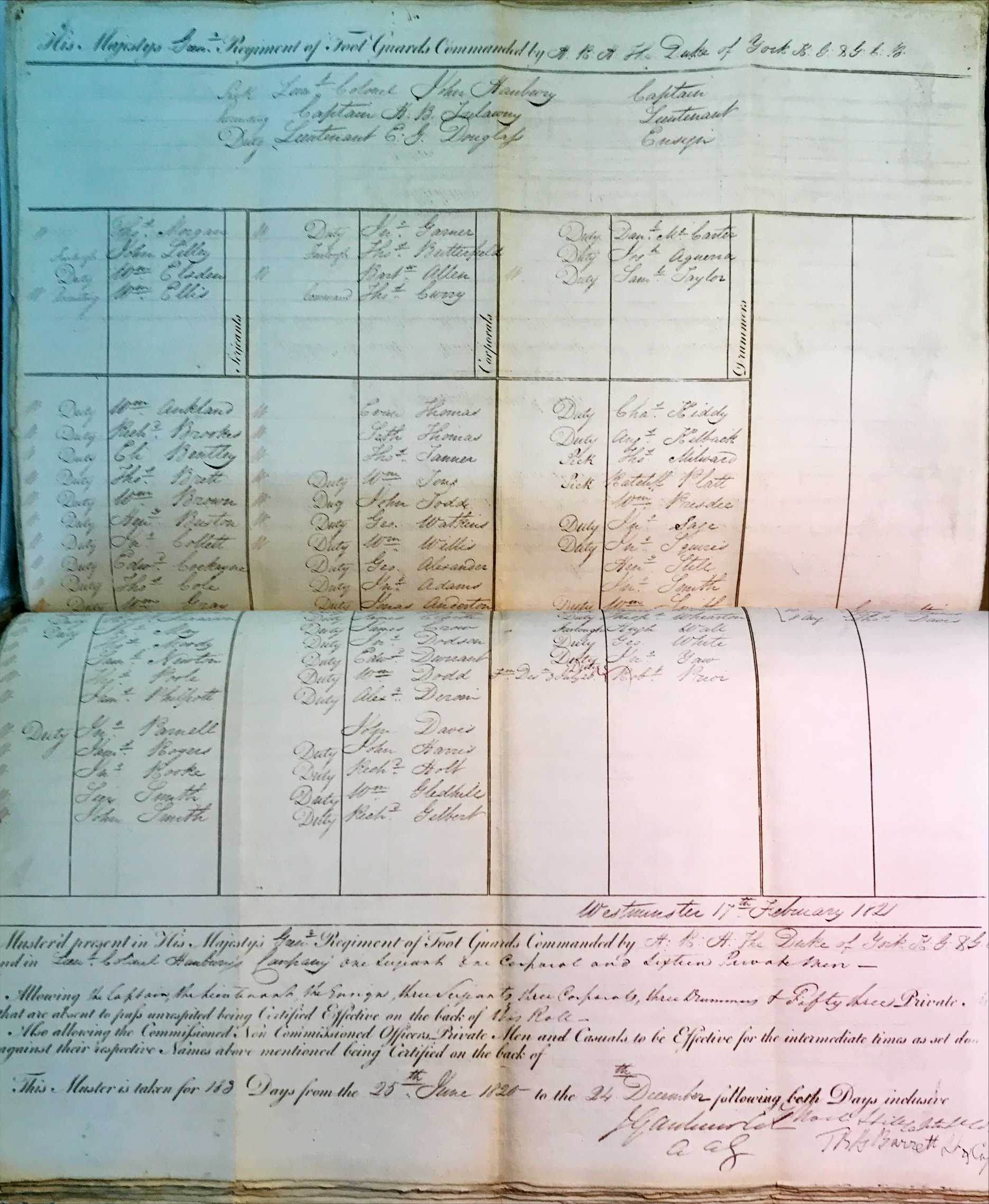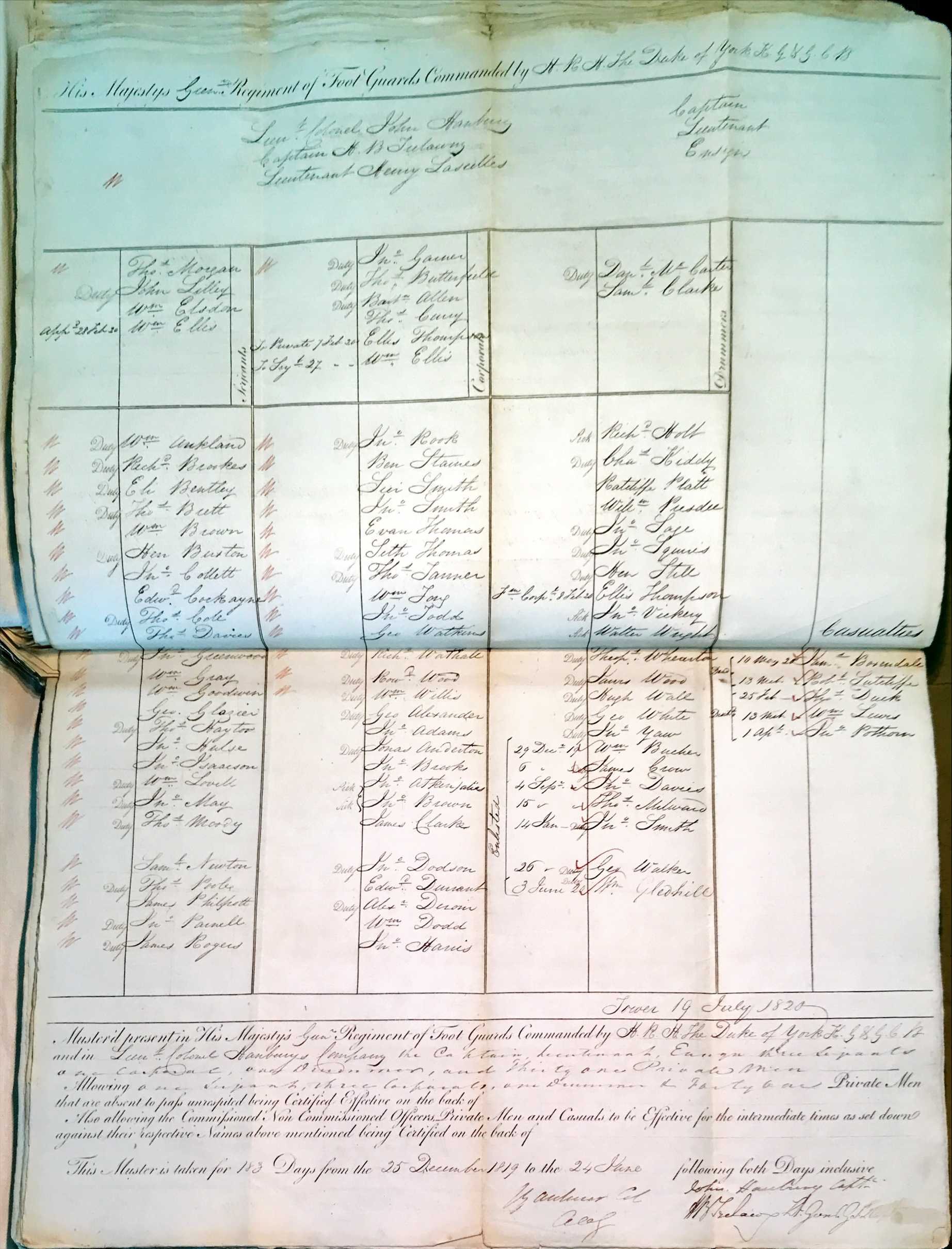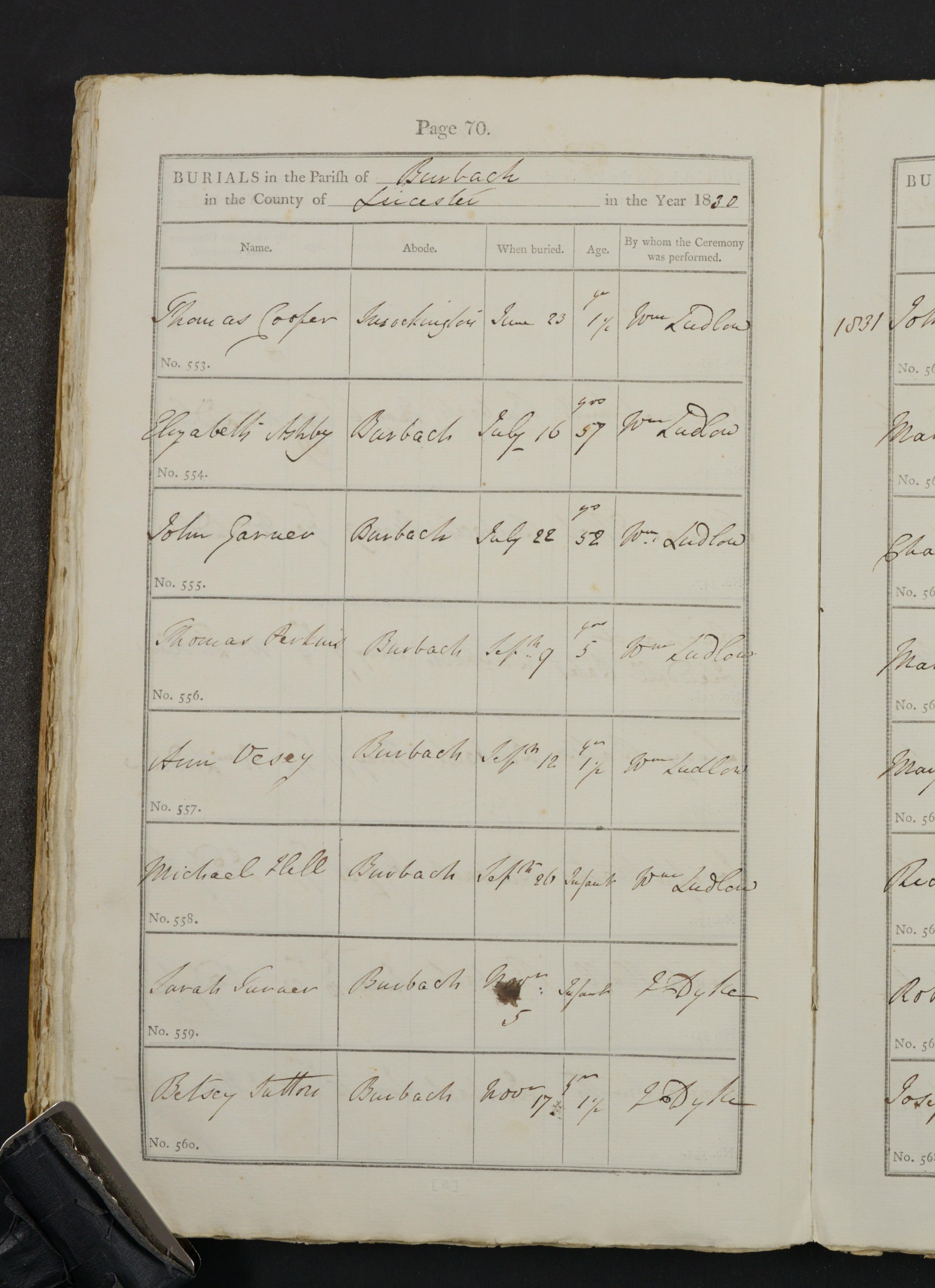Based on John GARNER's enlistment attestation papers, Serjeant John was initially framework knitter from Burbage and was born Oct 1776 - Oct 1777. His age at his death on 21 Jul 1830 was 52 suggesting a birth range of Jul 1777 - Jul 1778. Taken together this suggests he was born between 22 Jul 1777 and 16 Oct 1777.
At that time the master stocking makers took apprentices from the neighbouring villages - including Burbage - ill used them in order to get them to enlist; and then pocketed part, if not all, of the bounty1. This may have been John's experience as he enlisted in the British Army in Colchester on 16 Oct 1799 aged 22.
His attestation papers confirm that he was a framework knitter from Burbage of fair complexion, grey eyes, and brown hair, and that he had voluntarily enlisted in the 1st Regiment of Foot Guards. He was not able to sign his name. Before 1806, British soldiers enlisted for life, or until they were unable to continue service due to age or infirmity.
Military life must have suited him as he was promoted to Corporal on 3 Mar 1801.
Family life
Corporal John GARNER is recorded in the Regimental Marriages Register as marrying Mary GARNER on 7 Feb 1802 in Burbage by J Dyke, Rector. From the Burbage Parish Records we know that John GARNER and Mary GARNER were both of this parish and Abraham FORRYAN (b 1777 in Burbage) and Jeremiah DAWSON were witnesses (although Jeremiah witnessed many marriages.) (A Thomas DAWSON joined the 1st Foot Guards in the same intake as John. Perhaps he was the Thomas DAWSON baptized in Stoney Stanton on 18 Oct 1777 by William and Fanny DAWSON, in which case he and John may have suffered the same experience and left to the army together. Another possibility, yet to be researched, is that he was John's half cousin via his grandfather's half-sister Elizabeth GARNER who married a DAWSON. A John FORRYAN of 'Burbridge' Leicestershire joined the 1st Foot Guards in 1810 and he might have been a younger brother of Abraham.) Banns for this marriage were read in Nov 1801.
John and Mary christened:
- William on 3 Oct 1802 in Burbage
- John "GRANGER" on 19 Mar 1806 in Burbage
- Catherine in 1808 in Burbage
- Martha in 1810 in Burbage.
It is thought that a mistake was made when a copy of the Burbage Parish Register was made. Possibly John's parents were erroneously named "GRANGER" instead of GARNER, or two similar-looking entries merged with the three forenames of the first and the surname of the second. We need to locate the original document or the bishop's transcript, but it's likely that the original was only copied due to its very poor condition. Alternatively, John may have been baptized near the 1st Guards depot in London or even in Sicily where Corporal John was most likely posted during 1806/7.
While William was likely conceived around the time of their marriage, John, Catherine and Martha must have been either conceived during furloughs or Mary and the children lived with John as camp followers. The 1st Foot Guards had bases in Deal, Chatham, Tower of London, Windsor, Colchester, Knightsbridge and Chelmsford, and between 1799 and 1806 the 1st Foot Guards did not see any overseas action, so a normal domestic situation would have been easy to accommodate during the first years of their marriage.
Military Career
In October 1803 John was promoted to Serjeant, however sometime during the second half of 1804 he was demoted to Private. By June 1805 he was back to being a Corporal, and in June 1807 was Serjeant again, where he stayed until shortly before Waterloo in 1815.
According to the regimental muster rolls of 1805 and 1806 Corporal John GARNER was in Colonel Henry Frederick Campbell's Company, part of the 3rd Battalion of the 1st Foot Guards. Captain Francis D'Oyly, who would later be killed at Waterloo, was their Lieutenant.
Until 1806, the 1st Foot Guards saw no overseas service. John was in England in 1805 when John's son John would have been conceived and was still in England in March 1806 when John "GRANGER" was christened in Burbage. It is likely that Mary was living with John in Deal and/or Chatham where the 3rd Bn 1st Foot Guards was stationed.
On 26 Jul 1806, 120 men of his company were marched to Ramsgate, en route to Sicily where they were to prevent Napoleon from crossing the Straits of Messina. The journey was slow, only reaching Plymouth by September only to be disembarked. In mid-September they re-embarked and arrived in the Mediterranean in late October. They were eventually landed in Catania, Sicily on 5 Dec 1806, over 4 months after leaving London. The 3rd Battalion were posted along the east coast with Corporal John GARNERs company in Augusta and Contessa, near Messina.
By all accounts the posting was uneventful. While there was a threat of invasion during the first half of 1807, nothing came of it. On 19 Apr 1807, Corporal John GARNER was “transferd” to Lt Col Francis Todds Company.
The summer of 1807 was extremely hot and there was much sickness in the troops. John may have fared better than most as he was promoted to Serjeant on 12 Aug 1807. Meanwhile, in Europe Napoleon threatened to invade Portugal and the 1st Foot Guards were ordered to Gibraltar. They sailed in October and arrived in Gibraltar on 1 Dec 1807, only to discover that Portugal had already fallen. They sailed to England for fresh orders arriving on 28 Dec 1807 and marched to Deal where they would stay until September 1808.
On 8 Jun 1808, John and Mary christened their daughter Catherine in Burbage. Catherine must have either been conceived prior to July 1806 (in which case, why delay the christening until June when John had returned to England in December?) or Catherine had been conceived in Sicily. Wives and young families commonly joined their husbands on campaign as camp followers which was highly preferable to a penniless existence in England as there was no pay for soldiers dependents left at home. NCOs, like John, would have had more chance of securing passage for their family, with privates wives having to take their chances with a lottery.
In August 1808, after a Spanish appeal for assistance from Britain, Wellesley landed at Mondego Bay in Portugal. Shortly afterwards the Guards were ordered to prepare for foreign service, and 8 Sep 1808 they embarked at Ramsgate and sailed to Corunna on the north coast of Spain. The transports containing 12,000 troops arrived in Corunna on the north coast of Spain in late October 1808. As the Corunna troops moved inland, a force of 30,000 British troops advanced from Portugal into Spain intended to take the fight to Napoleon. However, Napoleon had already made his move against the Spanish who had suffered heavy defeats. The British joined their forces near Madrid but failed to seize the initiative allowing the French to concentrate their forces against the more dispersed British forces. Realizing the danger, the British commander, Sir John Moore decided to retreat to Portugal, then made for Corunna instead. The retreat of the British, closely followed by their French pursuers, took them 250 miles through mountainous terrain in dreadful conditions of cold and snow and was marked by exhausting marches, privation, and suffering. A continual rear-guard action was needed, and many men were lost. One notable engagement occurred at Lugo, on 5 Jan 1809, where the 1st Foot Guards successfully checked the French pursuers. Ensign Blunt was specifically noted for his involvement, and, as he was Serjeant John GARNERs immediate superior in Lt Col Todds Company, this strongly suggests that John was involved in that action.
After dark on 8 Jan 1809, the Battalion left Lugo in a terrible storm. Marching without rest for four days they arrived in Corruna in the evening of 12 Jan 1809. By all accounts the 1st Guards lost fewer men than any other regiment and were the only regiment to arrive marching in good order. When the British reached Corunna, on 11 Jan 1809, the bulk of the transports had not arrived, but there were sufficient stores to re-equip the soldiers with muskets, cartridges, and shoes. Some of the cavalry horses, the artillery and casualties were embarked on the available ships and an infantry defence of Corunna prepared. On 16 Jan 1808, thinking an attack unlikely, Sir John Moore started embarking his troops onto the now arrived transports, but by 2pm he learned that the French were attacking. Fierce fighting took place in and around Elvina where the British initially captured the village only to be pushed back again towards Corunna. Sir John Moore called up the reserves, including the two Battalions of the 1st Foot Guards, before receiving a mortal wound from a cannon ball that took his arm off. The reserves pushed the French back out of Elvina. After a long firefight, where the 3rd Bn (and presumably Serjeant John GARNER) again distinguished themselves, the fighting petered out and at the end of the day the French retired. The next day, the remaining British forces embarked and sailed for England with the Spanish garrison covering their departure before surrendering. The battle had cost 900 men dead or wounded and 6,000 cavalry and artillery horses. The French went on to capture huge stores of war materiel supplied to the Spanish by the British in other forts in Spain. By the time the retreating British army returned to England some 6,000 soldiers had reported ill. Serjeant John GARNER arrived back in Chatham on 8 Feb 1809. The campaign was considered a humiliating disaster but, by all accounts, the 1st Foot Guards had acquitted themselves well.
In July of that year, the 1st and 3rd Battalions of the 1st Foot Guards were sent to the Netherlands. The campaign objective was to open a new front in Austrian Empire's struggle against France and destroy French ship being built in Antwerp. In a deployment larger than that seen in Spain the previous year, 40,000 troops and 15,000 horses landed at Walcheren on 30 Jul 1809. The 1st Foot Guards landed on 2 Aug 1809 and were held in Reserve. There was little fighting, but there were heavy losses from the sickness dubbed "Walcheren Fever". Four thousand British troops died during the campaign, but only 106 died in combat. The 1st Foot Guards returned in early September 1809 and returned to barracks. Of the 2574 NCOs and men sent to Walcheren, 21 died abroad and 208 after their return to England. In October 1809, the muster roll for Johns Company records that out of 180 NCOs and men, only 2 Serjeants (one was John) and 10 men were available service, with the remainder being sick. Even Johns Company commander, Lt Col Francis Todd, succumbed and retired in October 1809 to be replaced by Lt Col A W Durnford.
1810 was a quiet year spent in London and Windsor for 1st and 3rd Battalions. It is likely that much of the time was spent recruiting and training the new recruits. Johns domestic situation was normalised and John and Mary christened a daughter, Martha, on 12 Sep 1810.
While John had been in London, the 2nd Battalion 1st Foot Guards had been posted to Cadiz which was under siege by French forces. In a sortie from Cadiz in March 1811, the British forces engaged with the French at the Battle of Barossa where six French colours were captured, but which resulted in large numbers of casualties. In April 1811, half of the companies of the 1st and 3rd Battalions left for Cadiz, to relieve the 2nd Battalion while the remaining companies were paraded in London in public celebration of the captured colours. These companies then also sailed for Cadiz reuniting the Battalions in Cadiz at the end of June 1811. A good number of men from 2nd Battalion were transferred into the 1st and 3rd before the rump of the 2nd returned to England. The 1st and 3rd Battalions would not return to England until August 1814.
The siege of Cadiz continued into 1812, with the 1st Foot Guards engaged in constructing new defences. In August 1812, six companies of the 3rd Battalion took boats to Huebro and marched to Seville where the British forces defeated the French, took Seville and thereby caused the siege of Cadiz to be lifted. The remaining companies left Cadiz on 1 Sep 1812, and together they a series of marches across Spain, to Talavera, Madrid, the Escorial Palace, Salamanca, before offering battle to the French at Arapiles which the French declined.
With winter approaching, Wellington withdraw his troops back to Portugal via Ciudad Rodrigo. The 1st Foot Guards wintered in Mundao, but camp fever hit them almost immediately. During December 4-5 soldiers died every day. In April that they were moved to better quarters in Oporto, but during the first half of 1813, 801 out of the 2500 Guardsmen died of fever. Once again John survived.
In May 1813, Wellington crossed back into Spain, captured Burgos, Valladolid and Santander, and won the Battle of Vitoria. The recovering 1st Foot Guards left Oporto on 29 June and arrived at Vitoria on 10 July. They arrived at San Sebastian on 18 Aug 1813 to provide cover for the troops besieging the fortress there. On 31 Aug 1813, following prolonged artillery bombardment that had opened a breach in the walls, an Allied force - including 200 volunteers from the 1st Foot Guards under the command of Johns Company commander, Lt Col R H Cooke made a successful assault on the fortress. Of those 200 Guardsmen, only 50 survived.
Following the surrender of San Sebastian, the Allies continued up the Atlantic coast crossing the Bidassoa with few casualties on 7 Oct 1813, and fought the Battle of Nivelle on 10 Nov 1813, followed by the Battle of the Nive in December. The French had effectively been driven from Spain.
The Guards wintered in St Jean de Luz. On 24 Feb 1814, they crossed the Adour and infested Bayonne, commencing a siege of the Bayonne fortress. Meanwhile on Frances Eastern Front, the Allies had defeated the remaining French forces, and entered Paris in late March. Napoleon abdicated on 6 Apr 1814. Unfortunately, this news did not reach Bayonne in time to prevent a sortie from the fortress which, while repulsed, cost the Guards 3 dead and 37 wounded. News of the peace deal arrived in Bayonne in June 1814, and the subsequent surrender allowed the 1st Foot Guards to sail to England from Bordeaux on the Tigre, Belle Poule and Freya on 26 Jul 1814. After landing in Portsmouth, they arrived in London on 10 Aug 1814.
By 25 Dec 1814, John had a new Company commander, Lt Col William Miller. He had been John's Company Lieutenant in Sicily and may have been involved in Johns transfer to another Company in 1808. On 24 Feb 1815, John was reduced to Private - for some unknown reason - and moved from Miller's Company to Lord Fitzroy Somerset's Company in the 2nd Battalion. Was this payback for something that happened 6 years earlier? Whatever the reason, it was in this new Company that John GARNER would fight at Waterloo.
John GARNER's Waterloo Campaign
The 2nd Battalion had been garrisoned in Brussels since September 1814, so John may have had to travel to Belgium immediately to join them, or he may have travelled with the 3rd Battalion when they travelled on 9 April 1815, first to Greenwich, then on transports to Ostend, then by barges to Bruges and then Ghent. The records state that the 2nd Battalion received 41 replacements, and John may have been one of these men. Major General Peregrine Maitland was given command of the 1st Brigade which comprised the 2nd and 3rd Battalions of the 1st Foot Guards and which was billeted in/near Enghien (18m SW of Brussels).
In an account of the start of the Waterloo campaign by Henry SWAN, a Private in Miller's company and someone who John GARNER would have known well, wrote "And in March we were ordered out again, when all the strong and active young men were picked out to fill up the other two Battalions [i.e. the 2nd and 3rd], when we marched out of London with the Duke of York at our head to the Greenwich College yard and went onboard there and landed at Ostend and marched to Ghent and from hence to Enghien. There the 3rd Battalion laid in barns and the others in the town."
Around 14:00 on 15 Jun 1815 the Guards were alerted to be ready to move. At 01:30 the drums beat, but the 1,077 men of the 2nd Battalion did not start marching south until 04:00, possibly delayed waiting for officers returning from the Duchess of Richmond's ball in Brussels. They marched to Steenkerque then Braine-le-Comte where they arrived at 09:00. During the day they marched to Nivelles, and after having marched 25 miles in 12 hours they thought they could rest. They set up bivouac and started to cook. Then new orders arrived. While they were waiting to move out, the married men whose wives had followed, said their goodbyes and handed over valuables, while other men sent messages to absent loved ones. The camp followers were then sent to the rear, and the Guards marched off at Quick Pace (108 paces/min) towards Quatre Bras.
As soon as the 2nd Battalion arrived it was sent into the Bois du Bossu woods and were instantly engaged; despite having been up since 03:00 that morning and having marched 32 miles that day. The 3rd Battalion were sent in to reinforce and after an hour's fighting approximately 1,000 French troops had been pushed out of the woods. The battle ebbed and flowed and at 20:00 Marshall Ney made one last effort to break the British line. The 2nd Battalion took a position in a sunken road and the "men threw in so destructive a fire as to nearly annihilate them". They were also protected against the French skirmishers that followed, but the 3rd Battalion (John's old Battalion) were not so well protected and took heavy casualties. John's old commanding officer, Lieutenant Colonel William Miller, was wounded and died two days later. On being wounded he sent for his friend, Col. C. Thomas, and said, "I feel I am mortally wounded, but I am pleased to think it is my fate rather than yours, whose life is involved in that of your young wife." After a pause, he said: "I should like to see the colours of the regt. before I quit them for ever." They were brought and waved round his wounded body. "His countenance brightened, he smiled, declared himself well satisfied, and was carried from the field." Miller's second in command and the Serjeant who had replaced John were also killed in action. By 22:00 the fighting had died down and at 23:00 they were relieved and camped in the fields nearby.
The next morning, 17 Jun 1815, a roll call was conducted to assess casualties. They had been heavy. In John GARNER's Battalion, the 2/1st FG, 45 Serjeants and other ranks had been killed, with 98 wounded. The four officers who had died were buried. No effort was made to bury the dead enlisted soldiers.
By 11:00 the 1st Foot Guards began marching north. The soldiers were disgruntled at having to withdraw because they felt they had beaten the French at Quatre Bras and held the field at the end of the battle. Not all the seriously wounded had been evacuated by the time they left, and they were forced to abandon them, including twelve men from John's Battalion who were later recorded as having died. The day's march was 15 miles, but the heat and fatigue from the previous day's gruelling march and four hours fighting was taking its toll. Eventually they took up a position on a ridge overlooking the Hougoumont chateau, where they lay down on a wet ploughed field. One of the 1st Foot Guard Captain's wrote "the ground was of such a spongy nature that it soon became a bog and torrents of rain fell without intermission till the morning, the wind driving it along with prodigious force and peals of thunder filling up the intervals of lightnings". John GARNER's acting company Captain James Nixon was made responsible for picquet duty that night, so it is likely that John spent the night before the battle, on duty, in driving rain, searching for approaching Frenchmen.
In the morning of 18 June the men tried to build fires to dry out. They had had no food since the morning of 16 June but there was no food to be had. Of the 1,077 men in John's Battalion that had left Enghien, they could only muster 781 with 7 Serjeants, 2 drummers and 277 other ranks dead, wounded or sick. The men watched the French army form up 800 yds south of their position and they could hear music being played by the French bands. By 11:00 the battle had started with the French attempting to capture the farm buildings at Hougoumont. The Light Company of the 1st Foot Guards were deployed to reinforce it, but none of the other 1st Foot Guard companies were involved in the defence of Hougoumont. Throughout the attack on Hougoumont the 1st Foot Guards on the ridge endured almost continuous artillery fire. The two Battalions were formed in squares with everyone, except some officers, lying down. John's acting company commander, Lieutenant James Nixon, was lying down when his Captain, who was next to him, was hit by a cannonball. One of the Ensigns reported: "we were receiving the balls and shells, twelve men at a time being wounded and two or three blown up in the air". The situation in the squares was total carnage. Casualties mounted, but the men could do nothing. "Inside [the square] we were nearly suffocated by the smoke and smell from burnt cartridges. It was impossible to move a yard without treading upon a wounded comrade, or upon the bodies of the dead; and the loud groans of the wounded and dying were most appalling. At four o'clock our square was a perfect hospital being full of dead, dying, and mutilated soldiers." By this stage they had been under artillery barrage for four hours, and most of their officers had been killed or wounded.
At this point Napoleon launched a massive cavalry attack against the Allied army lines between La Haye Sainte and Hougoumont. The 1st Foot Guards were at the centre point of the French attack. Napoleon's earlier infantry attacks against the Allies at La Haye Sainte had been unsuccessful and he had received intelligence that the Prussian Army was approaching from the east. He had to act fast, so he ordered 4,000 cavalrymen, including the heavy shock-troop Cuirassiers and the experienced Chasseurs and Lancers of the Imperial Guard, to attack. The cessation of the bombardment was welcomed, but the men could see the cavalry forming. This was the first chance that the men had had to hit back at the enemy. The Allied artillery lay in front of their squares, so as soon as the men saw the gunners running back to their squares they stood up, the colour party with the colours unfurled. The French cavalry had yet to break into a gallop and were surprised by the sudden appearance of an infantry Battalion. Being too close to build up adequate speed they taunted the British hoping to draw them out. Being unsuccessful then retreated, then with a thunderous gallop attacked the 2nd Battalion's square, again unsuccessfully. The Guards put up a withering fire, bringing down the horses then finishing off the fallen men who were caught in the mud. This attack went on for over three hours with successive waves of cavalry attempting to break the lines. The bravery of the French was remarkable.
By 17:30, the attacks dwindled, and the Guards took the time to re-organize their square, distribute ammunition, and evacuate their wounded. This respite did not last long. At 18:00 the French Reserve Cavalry Corps attacked, this time with infantry and artillery support, but the French horses refused to get closer than 20 yards from the British bayonets. The artillery did cause breaks in the square and some courageous French attempted to exploit these gaps, but they were quickly surrounded and killed.
While this was going on, the French had been attacking, and capturing La Haye Sainte in the Allied centre, allowing their horse artillery to move close to the Allied lines and start to blow large gaps in it. Things were looking desperate for Wellington to the extent that the Hanoverian cavalry - the only fresh cavalry left - fled the field causing panic all the way back to Brussels. The British and Dutch squares now endured a horrendous bombardment of canister from the French guns and musket-fire from advanced tirailleurs (skirmishers). Squares were being decimated and had to combine with others to retain their effectiveness. The skirmishing French infantry were very effective against the Allied officers - many of Wellington's generals and aides were killed or wounded at this time - so the 3rd Battalion 1st Foot Guards were ordered to move forward to flush out the tirailleurs. Advancing over the ridge they evicted the skirmishers but became the target of the French canister. The French infantry advanced and a vicious firefight began with the Guards soon running low on ammunition. Suddenly the French infantry broke off, but only to allow a French cavalry charge that fortunately veered off at the last moment. The French artillery then restarted its work on the 3rd Battalion, and they were ordered to withdraw. Lieutenant James Nixon, John's company commander later wrote: "Our squares stood in the face of grape, shell and everything else, which caused the Guards a terrible loss, without being able to return a shot."
About the same time reports started arriving that the Prussian army had belatedly joined the battle and were advancing Napoleon's right flank. The disheartened French had expected their own forces to arrive from that quarter having beaten the Prussians the previous day. Napoleon has one last chance to win the battle and he deployed his last reserve, the 14,000 men of the Imperial Guard, intending to punch through the weakened British lines and roll them up away from the Prussians. Seven Battalions of Grenadiers and eight Battalions of chasseurs of the Old Guard and four Battalions of tirailleurs and voltigeurs from his Young Guard, supported by cavalry and artillery were sent forward.
Ranged against these fresh troops the Allied divisions waited, having been in the battle for 8 hours and having already lost 40% of their men. By the time of the attack at 18:30, John GARNER's Battalion was down to 600 men (from 757) while his old one, the 3rd Battalion, was down to 500 (from 824). They were to have no help from their artillery support which had left the field in search of ammunition.
Wellington ordered the Guards to form into a four-deep line, rather than the traditional two-deep formation. The 2nd Battalion had about 140 men in each rank with a frontage of about 80-85 metres. The third and fourth rank could not fire forward, but they could re-load and pass muskets forward to increase the rate of fire of the men in front. As the 2nd Battalion reformed, they crossed the ridgeline which brought them precisely to the point where the Emperor had chosen for his attack. The French artillery resumed bombarding the Allied lines. During this bombardment Captain D'Oyly, the commander of the 2nd Battalion was killed. While his men had been ordered to lay down, he had remained on horseback.
Five French Guard Battalions in the first wave approached in square interspersed with horse artillery negotiating the mud, and hundreds of bodies of men and horses, many in screaming agony from wounds. This not only slowed the attack and broke down unit cohesion but must have had a strong psychological impact on the attackers. The attackers formed into two columns and headed directly at the two 1st Foot Guard Battalions which were outnumbered 3-1 and had been pummelled by artillery. The French paused twenty paces from the front of the 1st Foot Guards, perhaps thinking that they were looking at more dead and dying Allied soldiers lying in the mud. At this moment General Maitland gave the order for the Guards to stand up and fire. Lieutenant Powell of the 2nd Battalion wrote "Whether it was from the sudden and unexpected appearance of a Corps so near them, which must have seemed as starting out of the ground, or the tremendously heavy fire we threw into them, La Garde, who had never before failed in an attack suddenly stopped. In less than a minute about 300 were down. They now wavered, and several of the rear divisions began to draw out as if to deploy, whilst some of the men in their rear beginning to fire over the heads of those in front was so evident a proof of their confusion." The British fire brought down all their senior leadership. The French wavered and started to back up. General Maitland gave the order to charge. Lord Saltoun "holloaed out, "Now's the time, my boys". Immediately the Brigade sprang forward. La Garde turned and gave us little opportunity of trying the steel". The French ran as fast as they could with the British climbing over the hedge of bodies to get down the ridge after them.
Some of the men stopped for souvenirs from the dead and dying French officers, but with another French wave waiting to advance, order was restored, and the men reformed on the ridge. They then began to advance towards the second column. Meanwhile the 52nd Foot formed a skirmish line and started assailing the remaining French column from their flank. The French were now outnumbered and saw the Guards descending the ridge towards them. They gave up the fight and retreated.
The withdrawal of the Imperial Guard - something that had never happened before - was seen by the rest of the French army. Panic ensued. Wellington ordered a general advance across his front.
The 1st Foot Guards moved down the slope reforming into their companies. As they arrived at Napoleon's command post, at La Belle Alliance, the Prussians, who had just arrived, played 'God Save the King', and saluted the Guards as they passed. The battle was over, and the regiment rested there.
The 2nd Battalion suffered 161 killed and wounded at Waterloo. Since Enghien it had lost 41 per cent of its men. The 3rd Battalion fared worse with 55 per cent casualties. Overall Wellington's losses were 15,000 dead or wounded and the Prussians lost 7,000. Napoleon losses were 25,000 killed or wounded, 7,000 captured and 15,000 desertions.
Search parties were sent out to locate and recover the wounded - and deter scavengers - and evacuate them to field hospitals. A roll call was taken and the men, who had not eaten since Nivelles two days earlier, looked for food at Hougoumont or in the knapsacks of the fallen soldiers. Some family members arrived in the encampments, although whether Mary was there is unknown.
The next day the regiment marched back to Nivelles through the battlefield. Over the next few days, they marched towards Paris crossing into France at Malplaquet. It rained most days and they bivouacked in the open as their tents and baggage had not caught up with them. By 25 June, the men had marched 100 miles from Waterloo in the rain with no shelter, having fought two battles, and they began to fall ill. Nevertheless, on 26 June after another 20-mile march, Wellington met them and ordered the 1st Foot Guards to Peronné, a fortified town 10 miles away, that had to be taken to protect Wellington's rear. It would take too long to besiege the town so it would need to be stormed. Fortunately, after an initial refusal to surrender by the French army, and after the Allied soldiers had breached the fortifications, the French surrendered. Just two Guards were killed. They were the last Guardsmen to be killed during the Napoleon Wars.
They marched out next day and arrived in Paris on 1 July and were picqueted at Montmartre. On 4 Jul 1815 the terms of surrender were signed, and they moved their camp to the Bois de Boulogne. Their duties were now to maintain a 24-hour guard at strategic points in Paris to maintain order, also they also had, at times, to provide an honour guard to the Russian Emperor who was visiting. Its not clear how much Private John GARNER would have seen of Paris as he would not have been allowed out of camp except when on duty. At the end of September, they moved into permanent barracks.
The 2nd Battalion began its journey back to London in December 1815, but in the Jun-Dec 1815 muster roll, dated 27 Feb 1816, John was still on “Foreign Service” suggesting that he had been transferred back to the 3rd Battalion, which had stayed in France as part of the Army of Occupation. A change is supported by the fact that his Company commander changed at this time to Lt Col Sir Thomas Noel Hill KCB. Shortly afterwards, on 18 Feb 1816, John was promoted to Corporal.
The 3rd Battalion remained in Paris until the end of 1816, but Johns "foreign service" didnt extend past July, although its not clear when his new Company returned to England.
Private John GARNER was awarded two years bonus service for his involvement in "Waterloo". He was awarded the Waterloo medal.
In the weeks that followed the Battle of Waterloo, the regiment was awarded the name "The Grenadier Guards" and allowed to wear the bearskin, in recognition of their defeating the French Imperial Guard 'The Invincibles' in the final decisive action.
An Army Extra Pay Account for Waterloo in 1815 indicates that John GARNER was given £8 12s 2d for 1033 days Waterloo service at 2d per day. This included two years for former service (if over 7 years) plus an extra day for each day during the period 25 Dec 1814 to 24 December 1815 inclusive. Given that he only accrued 1033 days, it would appear that he didn't qualify for the additional pay until 62 days after 25 Dec 1814, i.e. 24 Feb 1815. There is an annotation on his Extra Pay record that reads "Reduced 24 Feb 1815", and this is echoed in the Foot Guards Muster Roll for the first half of 1815 where he is listed as a Serjeant in Miller's Company and annotated "Reduc'd 23 Feby 15". This additional money might have reduced the financial loss from the reduction of rank.
On 27 Feb 1816, Private John GARNER was promoted to Corporal, and on 27 Dec 1820 he was promoted back to Serjeant.
One of John GARNER's last duties in the Grenadier Guards may have been forming part of the honour guard at the coronation of George IV on 19 Jul 1821. Perhaps he was one of the soldiers on duty at Westminster Abbey who famously barred the entry of Queen Caroline, who tried to gatecrash her husband's coronation.
John left the army on 24 Aug 1821 as a Serjeant having been a Serjeant for 9 years and Corporal for 9 years. His total service was 23 years and 310 days, including two years Waterloo bonus. When he left the army, his physical description was brown hair, blue eyes, fair complexion. He was 5' 8 1/2" tall.
His wife and a child, probably Martha who would be 11 years old, had been living with him in London and they were paid £1 12s 4 1/2d "Marching money", a travel allowance, for the 99 miles journey back to Hinckley as were all wives and children of honourably discharged soldiers.
According to his pension records, John GARNER died on 21 Jul 1830, aged 52. The Burbage parish records tell us that he was buried the next day.
Genealogical notes
There is still an element of doubt whether Serjeant John GARNER was the father of the John GARNER born about 1806 who married Hannah WELDON. The key problem is that there is no obviously correct baptism record for a John GARNER in Burbage in 1806.
There is, however, sufficiently strong evidence to believe that John was the son of Serjeant John GARNER based on the following.
- The Burbage Parish Register records the baptism of a John "GRANGER" in Burbage on 19 Mar 1806 by a John and Mary "GRANGER". There are no records of a John and Mary "GRANGER" marrying or for a couple of those names christening any further children in the East Midlands around that time. Furthermore, the handwriting and tone of the ink used in the surviving register is unnaturally consistent across the whole register covering 10 years of baptisms indicating that this was a later copy of now missing original records. These observations support the theory that there was no John and Mary "GRANGER" and an error was made by a clerk when copying the parish registers, perhaps many years after the event.
- Serjeant John and Mary GARNER baptized William in 1802, Catherine in 1808 and Martha in 1810. There is a suspicious gap in these christenings, which might be due to stillbirths/neo-natal deaths, but also perfectly fits with John "GRANGER"'s christening in 1806. We know that John was stationed in England during this period.
- Martha GARNER was a witness at John GARNER junior's wedding in 1826, suggesting a close familial relationship. The only local Martha GARNER at that time was the 1810 daughter of Serjeant John and Mary GARNER. This would make Martha GARNER, John's sister, and certainly a close familial relationship.
This matter might be cleared up by the original Burbage parish records if they have survived.
Outstanding questions:
HIS BIRTH FAMILY: Possible baptismal records:
- John GARNER baptized on 3 Mar 1778 in Burbage by John GARNER. There are two candidate families:
- John GARNER and Elizabeth ADCOCK - John, b.1741, was the second son of Richard GARNER of Burbage, a literate farmer. Elizabeth ADCOCK, daughter of George ADCOCK of Burbage, on 15 Oct 1777 and had 8 children. You would therefore expect his first-born son John to be literate unlike Serjeant John who couldn't sign his name when he enlisted in 1799, nor when he married in 1802. The date of the marriage is after the calculated birth date of John Jul-15 Oct 1777. Possible but unlikely. John may have been not have been John senior's son.
- John GARNER, servant of Lathbury, Buckingham and Elizabeth BATCHELOR married 1776 in Leicester. Could not sign his own, but no obvious link to Burbage.
- John GARNER baptized on 30 Sep 1778 at All Saints, Leicester by Joseph and Mary GARNER of Leicester. Their only child baptized in Leicester. No marriage has been found for Joseph and Mary. Possible Joseph GARNERs include:
- Joseph GARNER, b.1750, beneficiary of the will of his father John GARNER of Elmesthorpe in 1769, but married Patience HEFFORD in Burbage in 1776.
- Joseph GARNER, b. 1755, eldest son of Richard GARNER of Burbage, b. 1727, eldest son of literate farmer Richard GARNER of Burbage and brother to John above. Joseph was still in Burbage when he wrote his will in 1828 naming wife Elizabeth and his children as beneficiaries. Possible children included John bap. 1788 and d. 1788 in Leicester by Joseph and Elizabeth, or the John bap 1788 in Burbage by Joseph and Mary. If this is the right Joseph for the 1778 baptism in Leicester then that John must have died young, although no burial record for this has been found.
- Some other Joseph GARNER.
- John GARNER baptized on 2 Mar 1777 in Exhall, Warwickshire (10 miles west of Burbage) by John and Ann GARNER. Also baptized Ann 1779 and George 1781. John married Ann DOCKER in Foleshill in 1775 and signed his own name. This baptism would be slightly too early if John was born Jul-Oct 1777.
- John GARNER baptized 23 Jan 1777 in Swinford, Leicestershire (12 miles SE of Burbage) by Thomas and Ann GARNER who also baptized Robert 1772. I believe Thomas' father Thomas died intestate in 1771. Thomas signed the admon so literacy is again an issue. This baptism would also be too early if John was born Jul-Oct 1777.
- John GARNER baptized on 5 Oct 1777 in Church Eaton (44 miles) by James and Sarah GARNER.
- A missing entry in the Burbage register. A major problem is that the curate of Burbage failed to record baptisms between 1772 and Lady Day 1777. While some of the records were recovered, from the clerk's book, by the replacement curate, there are likely missing entries. That said it is thought that John was born after Lady Day 1777.
On balance the question of literacy must take lower priority over location and timing - particularly as the situation that drove his enlistment might have prejudiced his early book learning - so, at present, the preferred parents are John GARNER and Elizabeth ADCOCK of Burbage.
AN EARLIER MARRIAGE?: A John GARNER married Mary STEPHENS on 13 Oct 1794 at Stoney Stanton, which is 4 miles from Burbage. Witnesses were Thomas STEPHENS and Mary GARNER. They had a child Richard born on 23 Nov 1794 who was christened at Stoney Stanton on 21 Dec 1794. They subsequently had two further children christened in Burbage: Mary (9/3/1797) and Ann (10/9/1799). A Mary GARNER was buried on 11 Oct 1801 in Stoney Stanton where Mary STEPHENS was married from. Was this an earlier marriage of Serjeant John GARNER, or a different John GARNER? Was the witness Mary GARNER the same Mary GARNER that Serjeant John GARNER married? A John GARNER was buried in Burbage in May 1808. Was this the husband of Mary STEPHENS?
On balance, this is unlikely to be Serjeant John's first marriage for the following reason: Mary STEPHENS' husband John could sign his name when he married her in 1794, but Serjeant John could not sign his attestation papers in 1799 or his wedding papers in 1802. This John GARNER was more likely the son of John GARNER the literate farmer, but he may have been a cousin.
TIMING OF CHILDREN: How did John conceive his children while the 1st Regiment of Foot were on campaign in Europe? Johns son John was conceived and christened prior to Sicily. Indeed, we know that John was on duty in London during 1805, and we know that wives did live with the soldiers. Catherine must have been conceived prior to September 1807, however John was in Sicily (or in transit) between July 1806 and the end of December 1807. Did Mary join him in Sicily a real possibility? Or was Catherine conceived before he left in early 1806? Martha would have been conceived after John returned from the Walcheren campaign (i.e. Sep-Dec 1809) but before he left for Spain.
OTHER CHILDREN: A John and Mary GARNER baptized three children on 4 Jan 1818 at St Giles without Cripplegate, London: Mary Ann born 1 Apr 1809, Ann born 16 Feb 1811 and Elizabeth born 25 Aug 1814. Were these three children born on campaign, but only baptized on the return of John's Battalion (and Mary and the children) to England? NB Martha was baptized in Burbage in 1810 - after this Mary Ann's birth - so these are almost certainly a different family...unless Mary Ann was adopted. Ann would have been conceived in May 1810, when John was in London. Elizabeth would have been conceived in November 1813 between the Battles of Nivelle and Nive on the Spainish-French border. No Mary Ann, Ann or Elizabeth GARNER have been found near Burbage, and only 1 child was mentioned on the regimental marching money record in 1821.
Following up on the known children of Serjeant John GARNER
- Martha was witness to her brother John's marriage to Hannah WELDON in 1825, which was the key clue to identifying John junior's parents as Serjeant John and Mary GARNER. Martha died in Burbage on 20 Nov 1833 aged 23.
- Catherine died in Burbage on 6 Nov 1825 aged 17.
- William became a sawyer in Burbage, married Elizabeth and had children 8 children. If a descendent of William's could be found and they DNA analysed then we might be able to prove that John and Mary GARNER were John's parents.

